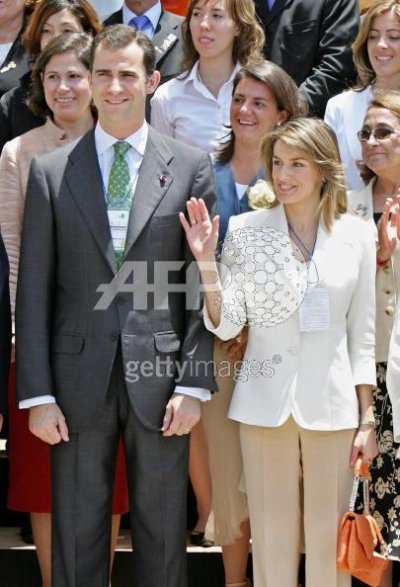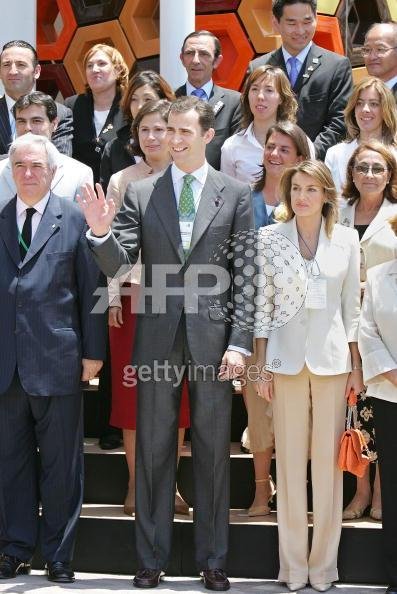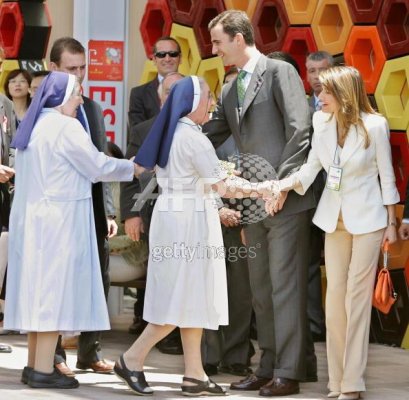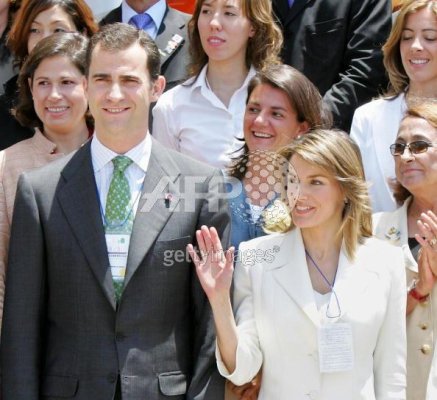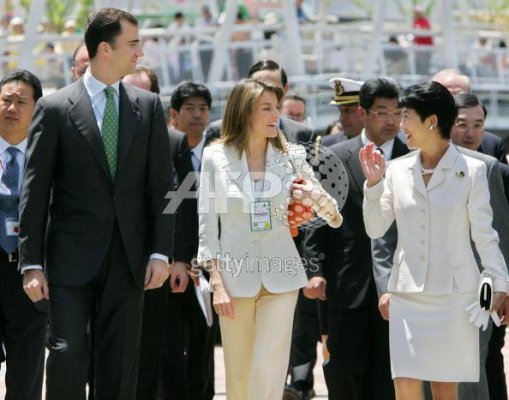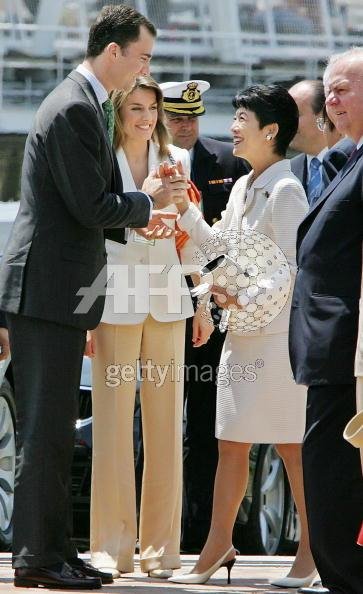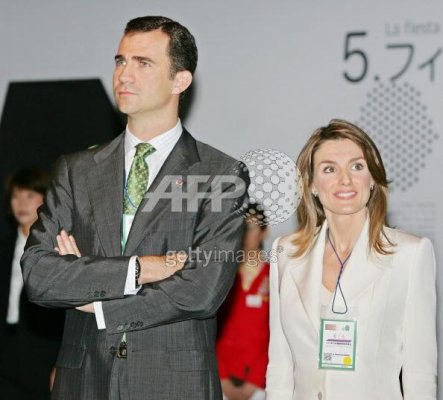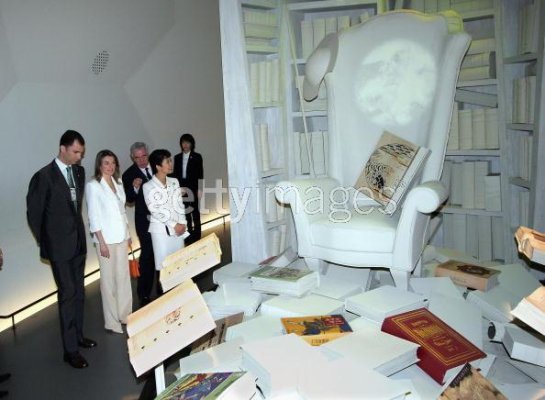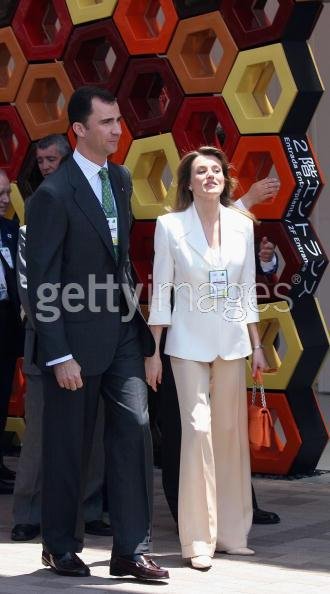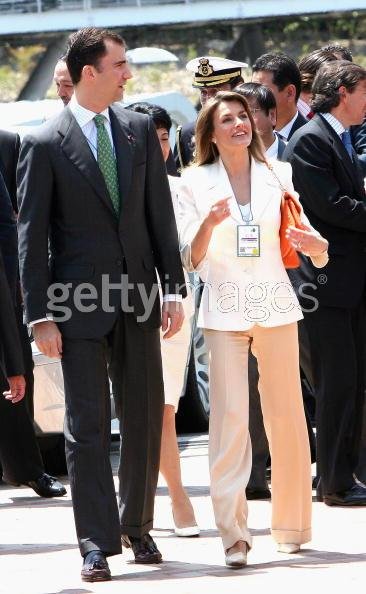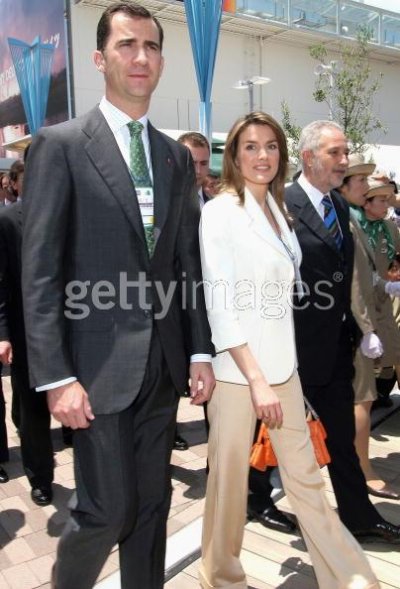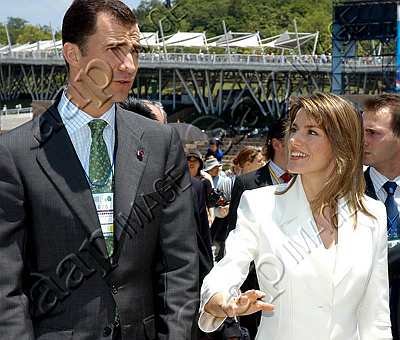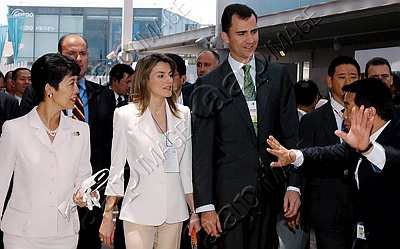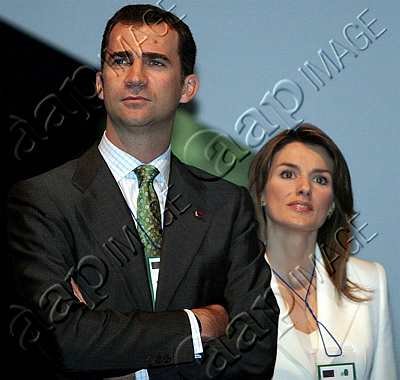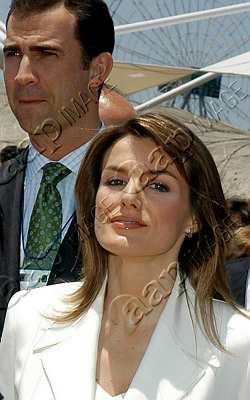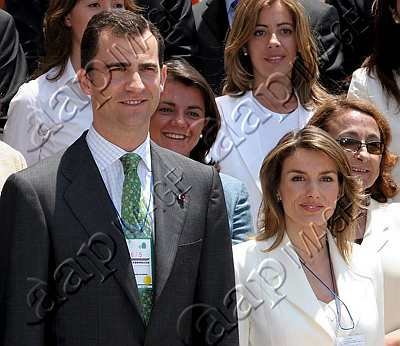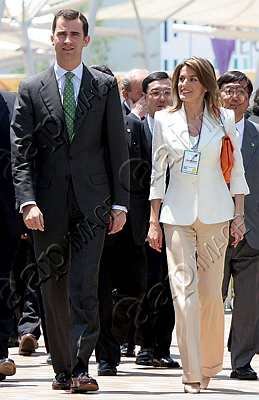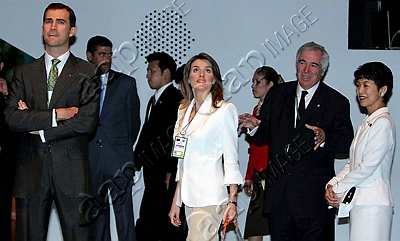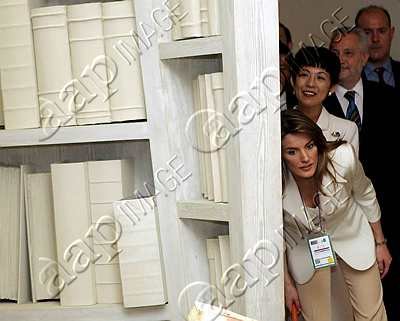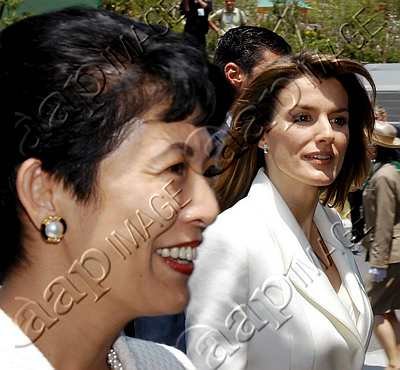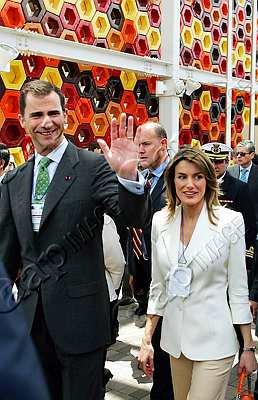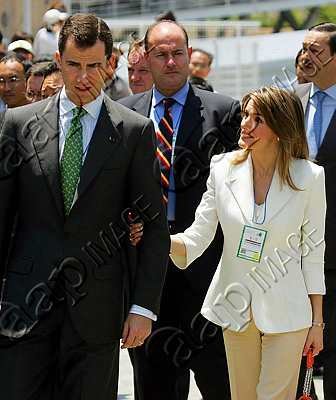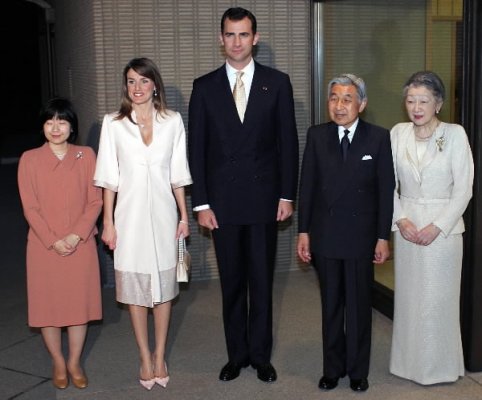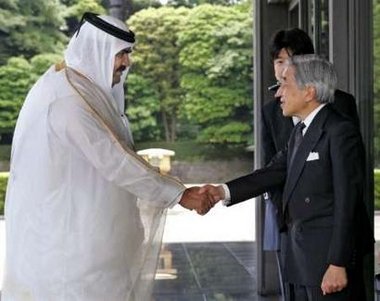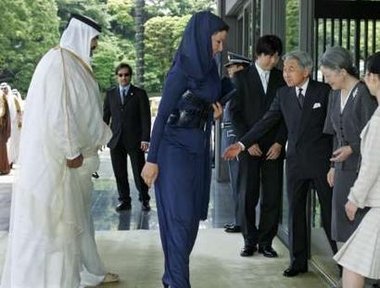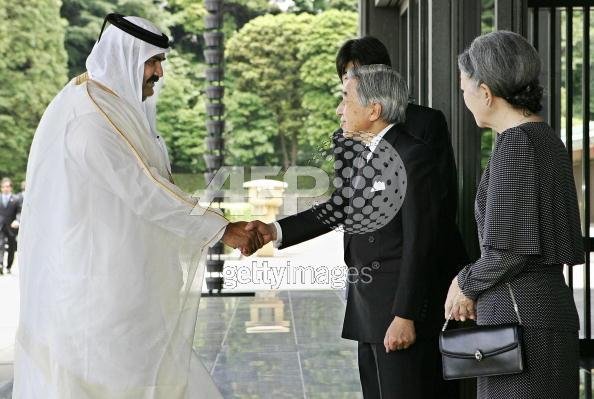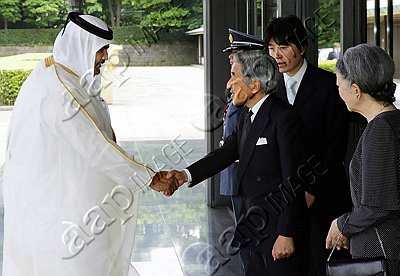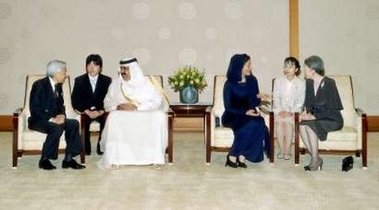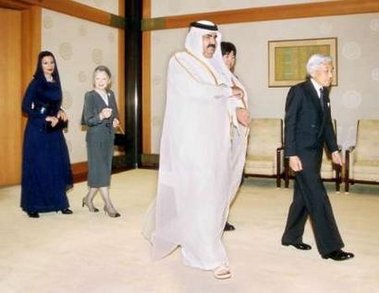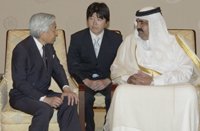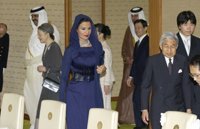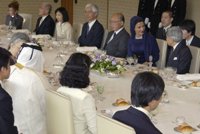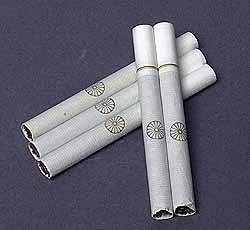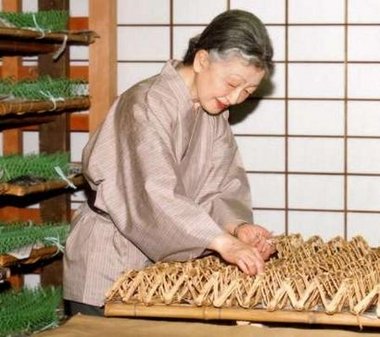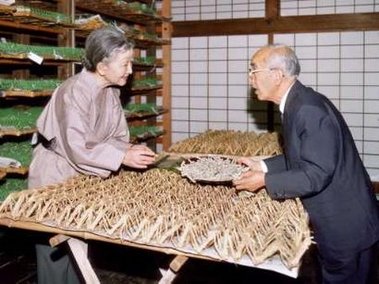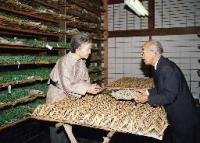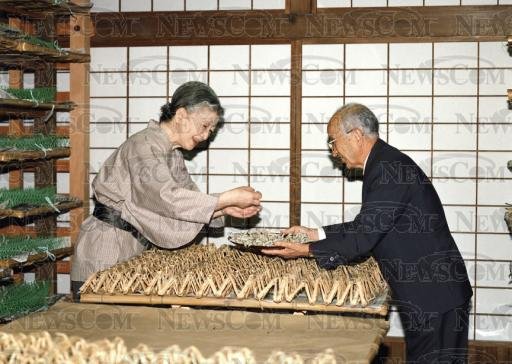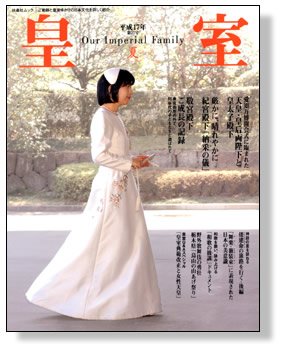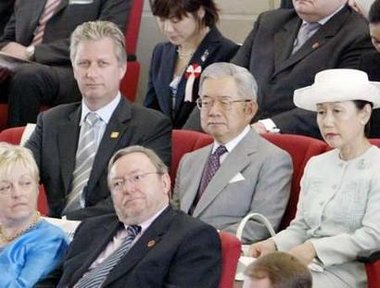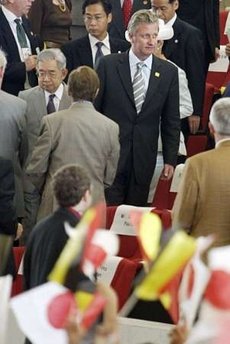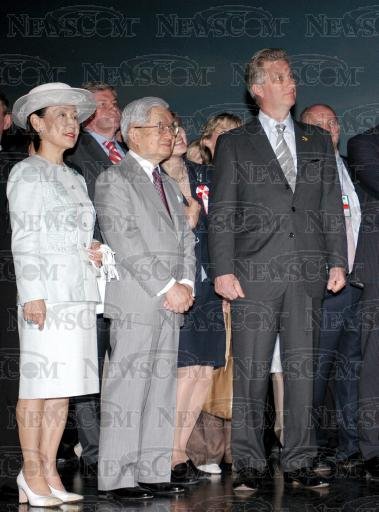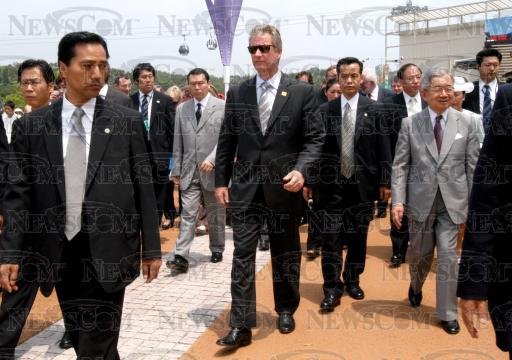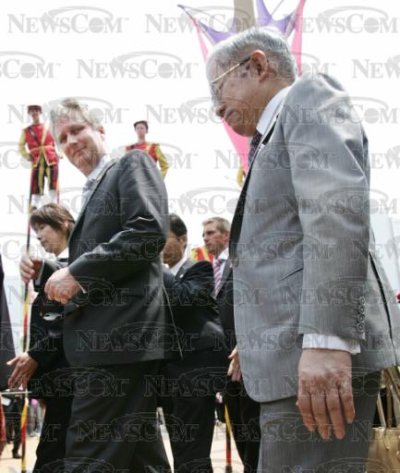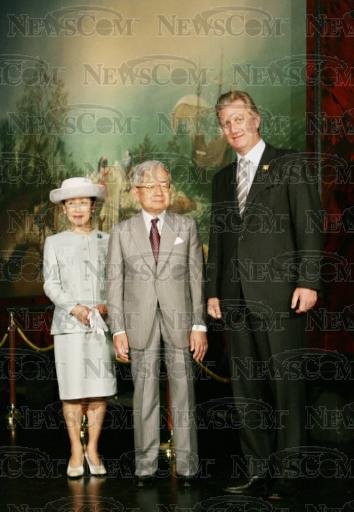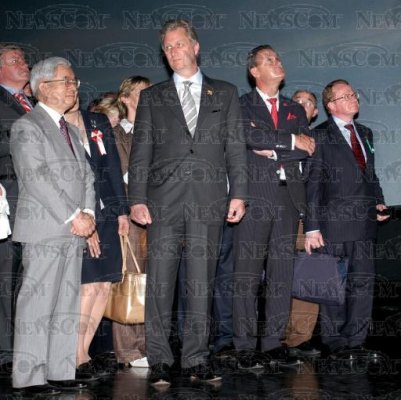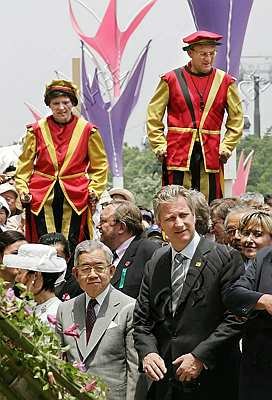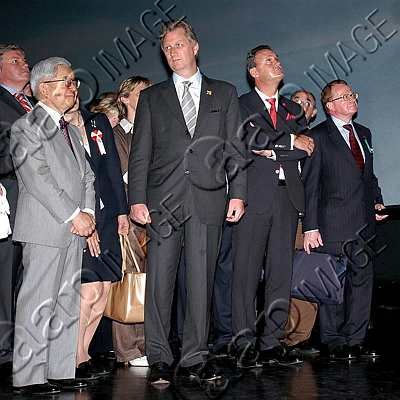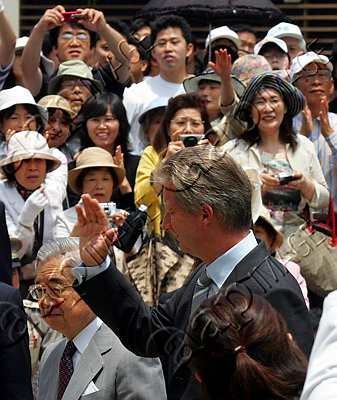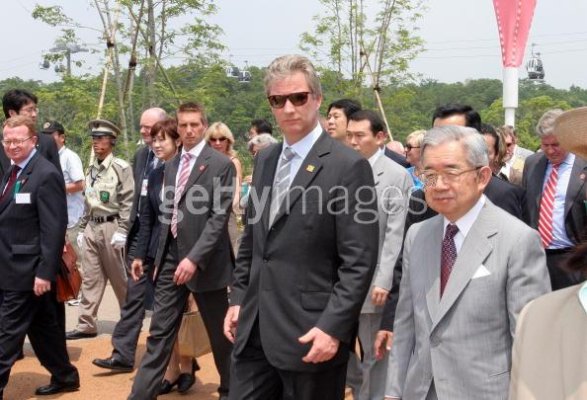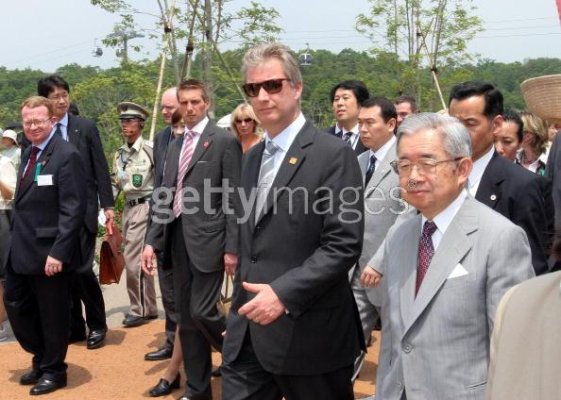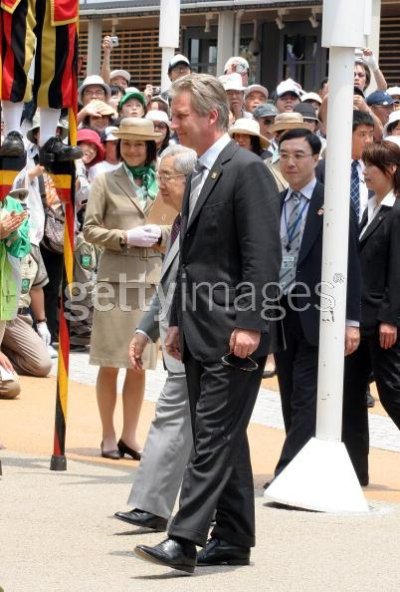NAGAKUTE, JAPAN: Spanish Prince Felipe (L) and his pregnant wife Princess Letizia (R) pose during a photo session with staff of the Spain Pavilion at the 2005 World Exposition in Nagakute, Aichi Prefecture, 05 June 2005. The royal couple is on a four-day visit to Japan. AFP PHOTO/Kazuhiro NOGI (Photo credit should read KAZUHIRO NOGI/AFP/Getty Images)
You are using an out of date browser. It may not display this or other websites correctly.
You should upgrade or use an alternative browser.
You should upgrade or use an alternative browser.
Imperial Family of Japan: News & Photos III
- Thread starter Mandy
- Start date
If you have answers, please help by responding to the unanswered posts.
- Status
- Not open for further replies.
NAGAKUTE, JAPAN: Japanese Princess Takamado (R) greets Spanish Prince Felipe (L) and his pregnant wife Princess Letizia (C) during a tour of the 2005 World Exposition in Nagakute, Aichi Prefecture, 05 June 2005. The royal couple is on a four-day visit to Japan.
Attachments
NAGAKUTE, JAPAN: Japanese Princess Takamado (2nd-R), Spanish Prince Felipe (L) and his pregnant wife Princess Letizia (C) take a tour of the 2005 World Exposition in Nagakute, Aichi Prefecture, 05 June 2005. The royal couple is on a four-day visit to Japan.
Attachments
-
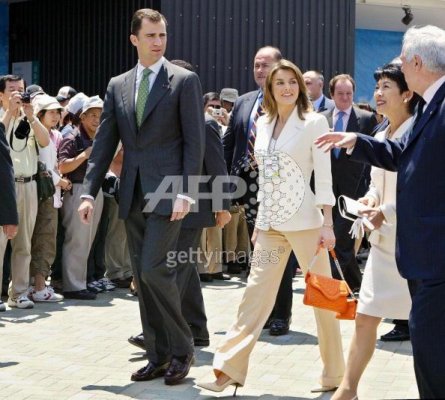 53022177.jpg60.8 KB · Views: 285
53022177.jpg60.8 KB · Views: 285 -
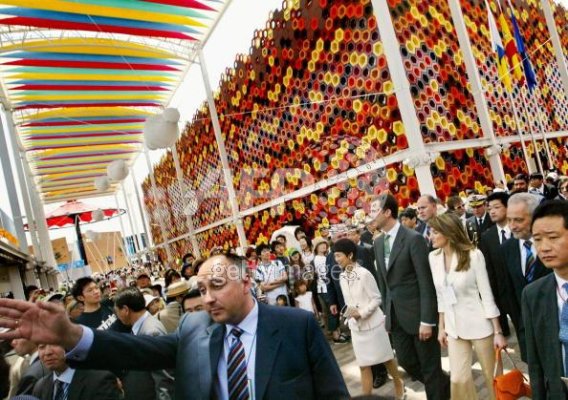 53022206.jpg76.3 KB · Views: 280
53022206.jpg76.3 KB · Views: 280 -
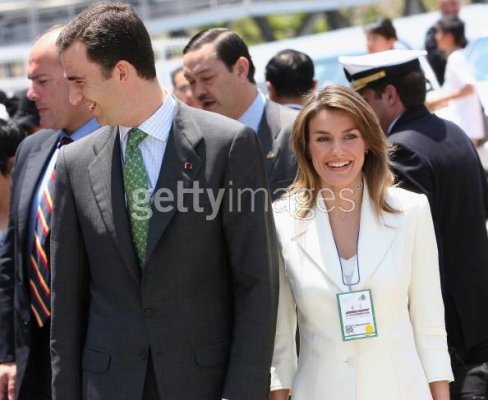 53022358.jpg42 KB · Views: 254
53022358.jpg42 KB · Views: 254 -
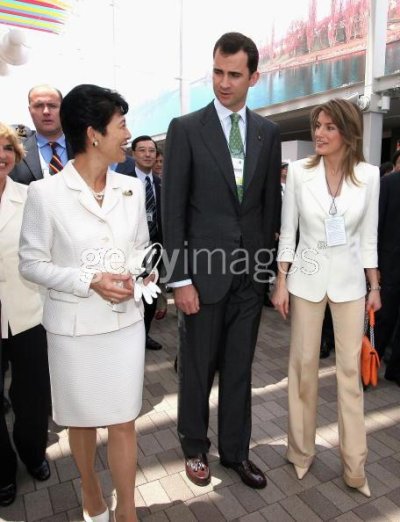 53022360.jpg45.5 KB · Views: 284
53022360.jpg45.5 KB · Views: 284 -
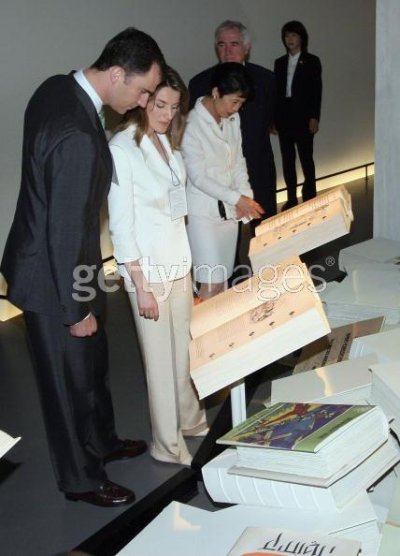 53022366.jpg36.1 KB · Views: 260
53022366.jpg36.1 KB · Views: 260 -
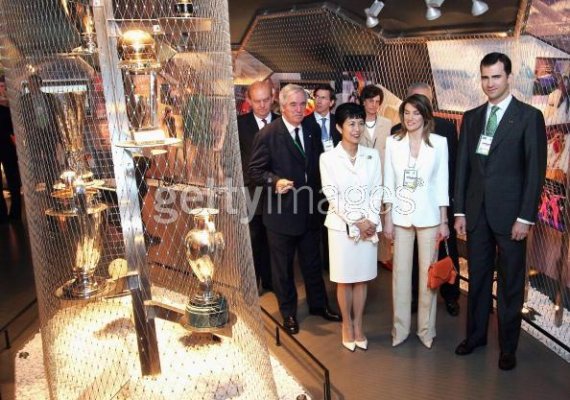 53022368.jpg66.7 KB · Views: 377
53022368.jpg66.7 KB · Views: 377 -
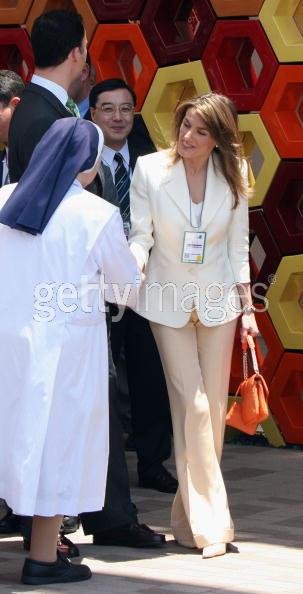 53022372.jpg29.2 KB · Views: 271
53022372.jpg29.2 KB · Views: 271 -
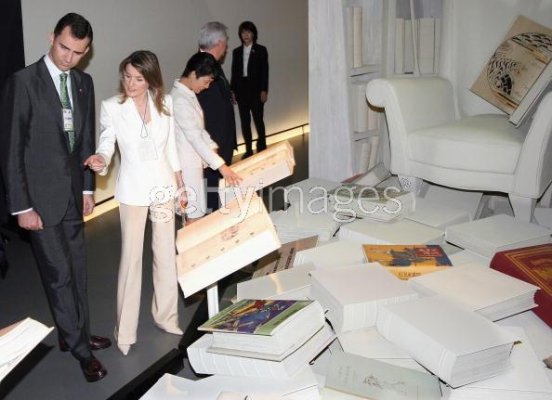 53022375.jpg39 KB · Views: 294
53022375.jpg39 KB · Views: 294 -
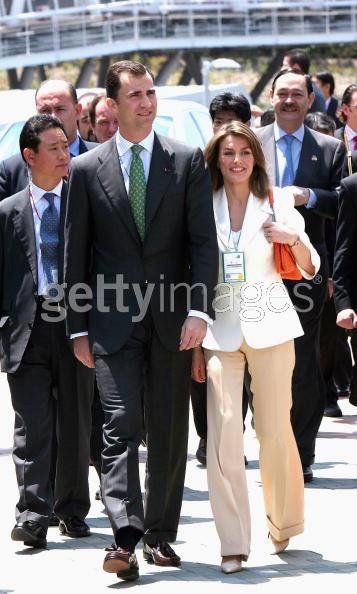 53022376.jpg41.6 KB · Views: 278
53022376.jpg41.6 KB · Views: 278 -
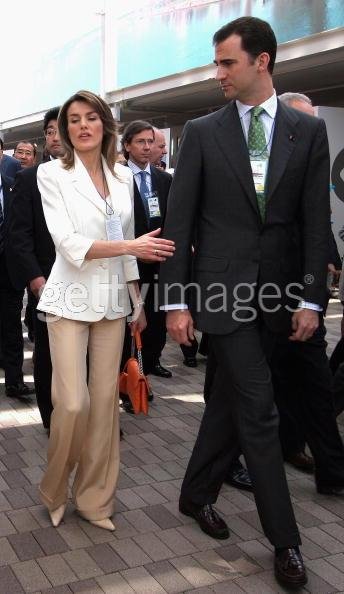 53022379.jpg32.8 KB · Views: 308
53022379.jpg32.8 KB · Views: 308
Last edited:
NAGAKUTE, JAPAN - JUNE 5: Spanish Crown Prince Felipe and his wife Princess Letizia and Japan's Princess Takamado (R) are escorted at the Spanish Pavilion at the 2005 World Exposition on June 5, 2005 in Nagakute, Aichi Prefecture, Japan. The Spanish royal couple are on a four-day trip to Japan during which they visit the World Expo at Aichi. Princess Letizia, the future Queen of Spain, is pregnant with the royal couple's first child and the baby is due in November.
Attachments
Sue-
Nobility
- Joined
- Jan 1, 2005
- Messages
- 304
- Country
- Germany
some more from Terra and the last one from dpa
Attachments
-
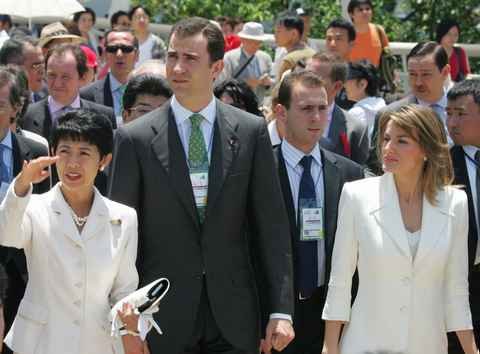 71f97876c38e9g.jpg19.3 KB · Views: 354
71f97876c38e9g.jpg19.3 KB · Views: 354 -
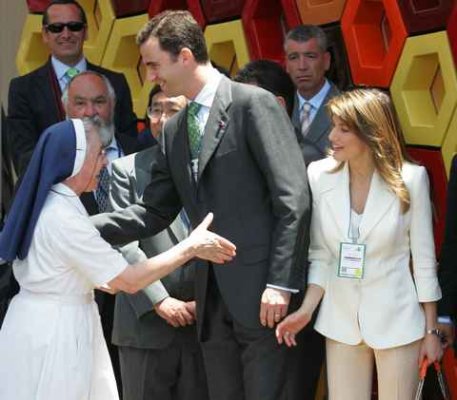 71f97876beb2cg.jpg20 KB · Views: 263
71f97876beb2cg.jpg20 KB · Views: 263 -
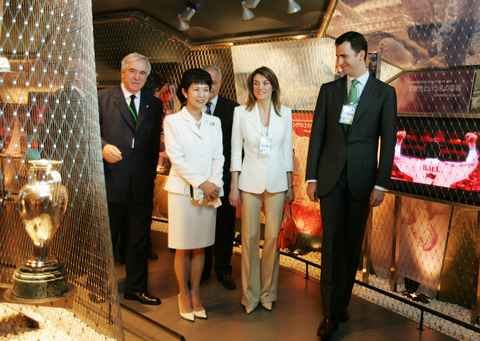 71f97876b9ca4g.jpg22.5 KB · Views: 281
71f97876b9ca4g.jpg22.5 KB · Views: 281 -
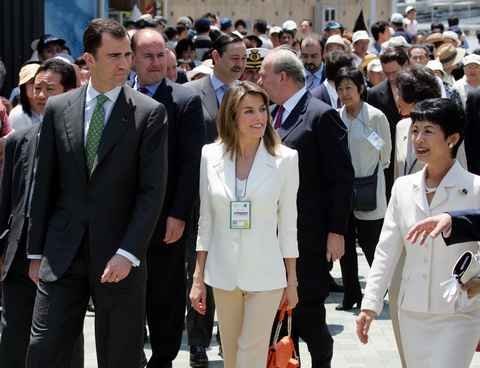 71f978769047cg.jpg20.9 KB · Views: 249
71f978769047cg.jpg20.9 KB · Views: 249 -
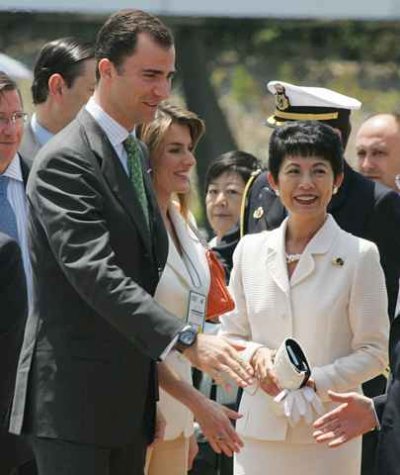 71f978759e984g.jpg19.3 KB · Views: 267
71f978759e984g.jpg19.3 KB · Views: 267 -
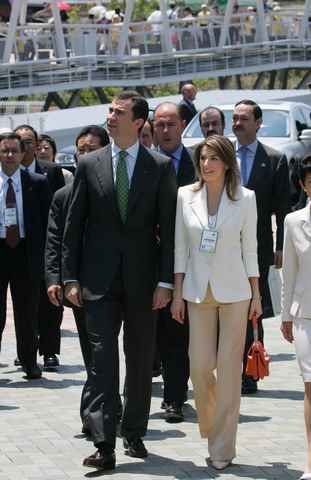 71f978759c273g.jpg18.5 KB · Views: 244
71f978759c273g.jpg18.5 KB · Views: 244 -
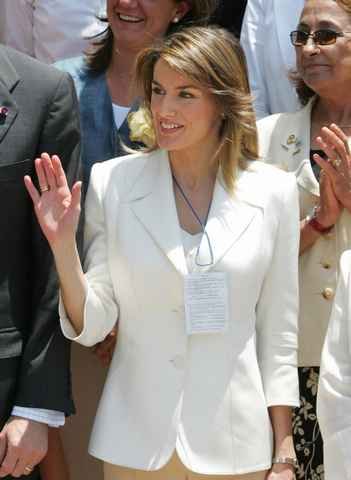 71f9787661e3cg.jpg15.1 KB · Views: 307
71f9787661e3cg.jpg15.1 KB · Views: 307 -
 71f97876685c2g.jpg18.5 KB · Views: 314
71f97876685c2g.jpg18.5 KB · Views: 314 -
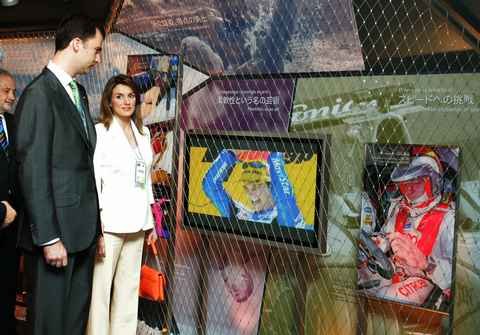 71f978768689fg.jpg24.1 KB · Views: 274
71f978768689fg.jpg24.1 KB · Views: 274 -
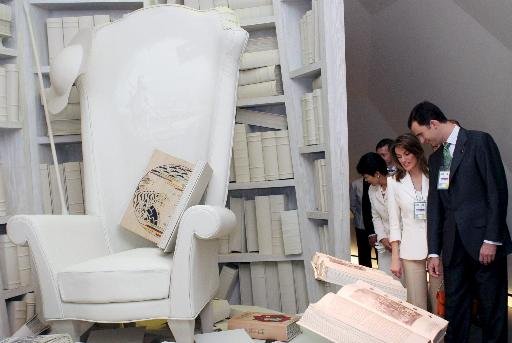 showLayoutImage77.jpg26.9 KB · Views: 340
showLayoutImage77.jpg26.9 KB · Views: 340
lucys
Courtier
- Joined
- Dec 31, 2003
- Messages
- 993
Some more of the always elegant couple from AAP.
Attachments
lucys
Courtier
- Joined
- Dec 31, 2003
- Messages
- 993
Elsa M.
Heir Apparent , TRF Author
- Joined
- Dec 4, 2004
- Messages
- 5,808
- City
- --
- Country
- Portugal
lapopdiva said:I did It!! My first attachments Thumbnails !! Thanks to mazerdote and Elsa for the Help!!
mandyy
Heir Presumptive
- Joined
- Oct 4, 2004
- Messages
- 2,615
- Country
- Canada
Spanish Crown Prince Felipe of Borbon & Crown Princess Letizia visited Spain Pavilion in Expo 2005 Aichi, JAPAN with Princess Hisako of Takamado -05/06/2005.
Attachments
-
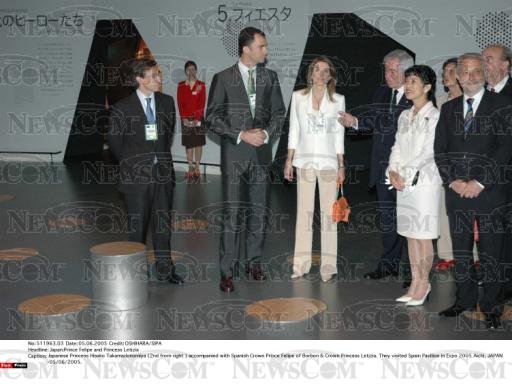 sipaphotos206896.jpg34.6 KB · Views: 493
sipaphotos206896.jpg34.6 KB · Views: 493 -
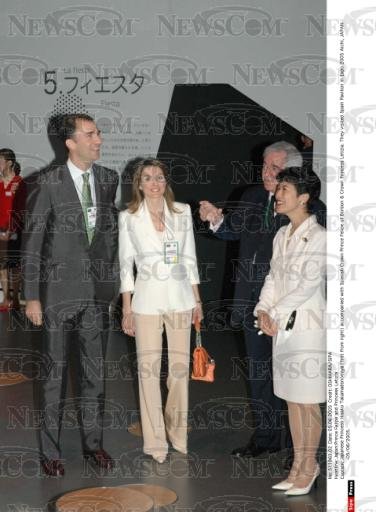 sipaphotos206901.jpg31.2 KB · Views: 335
sipaphotos206901.jpg31.2 KB · Views: 335 -
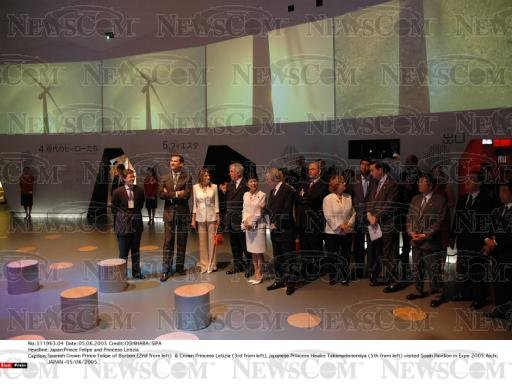 sipaphotos206912.jpg35.3 KB · Views: 332
sipaphotos206912.jpg35.3 KB · Views: 332 -
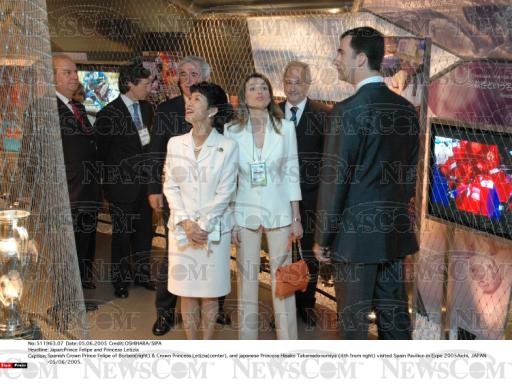 sipaphotos206917.jpg43.6 KB · Views: 374
sipaphotos206917.jpg43.6 KB · Views: 374 -
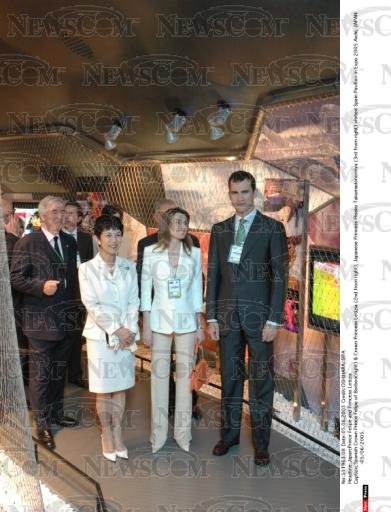 sipaphotos206921.jpg39 KB · Views: 291
sipaphotos206921.jpg39 KB · Views: 291 -
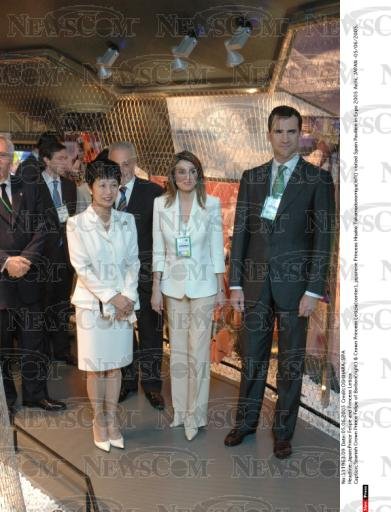 sipaphotos206927.jpg38.8 KB · Views: 306
sipaphotos206927.jpg38.8 KB · Views: 306 -
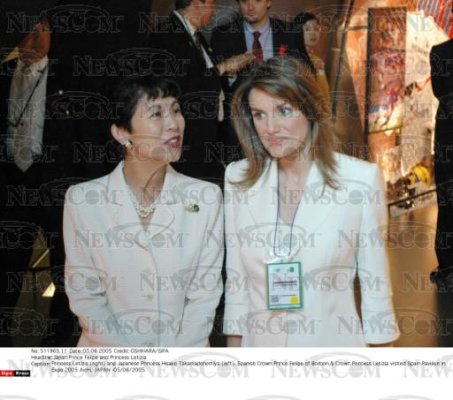 sipaphotos206930.jpg39.6 KB · Views: 321
sipaphotos206930.jpg39.6 KB · Views: 321 -
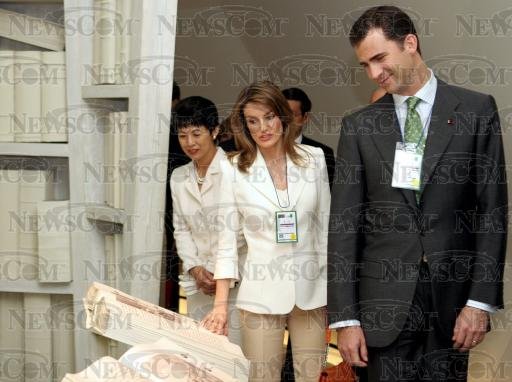 epaphotos357879.jpg33.4 KB · Views: 241
epaphotos357879.jpg33.4 KB · Views: 241 -
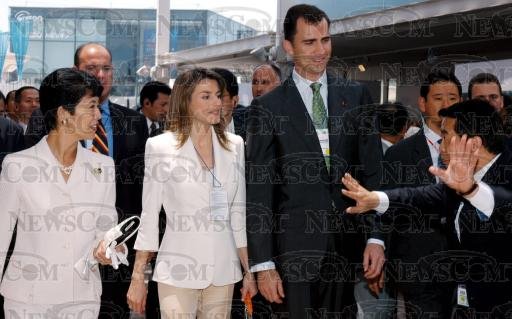 epaphotos357877.jpg32.6 KB · Views: 230
epaphotos357877.jpg32.6 KB · Views: 230 -
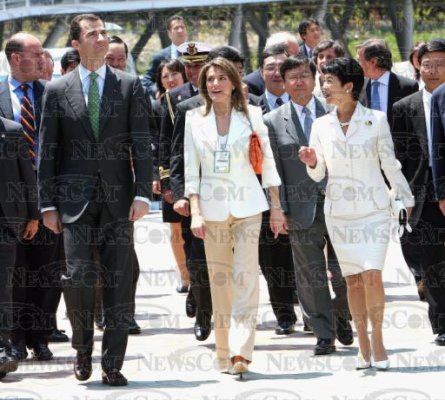 gettylive031791.jpg51.3 KB · Views: 294
gettylive031791.jpg51.3 KB · Views: 294
Last edited:
Mandy
Majesty
- Joined
- Feb 20, 2003
- Messages
- 6,920
- Country
- United States
Thanks everyone for the great pictures and news of Letizia & Felipe's trip to Japan. Too bad, we didn't get to see Masako, but Letizia looks radiant.
Congratulations lapopdiva on your first attachment success.
Congratulations lapopdiva on your first attachment success.
lucys
Courtier
- Joined
- Dec 31, 2003
- Messages
- 993
Spanish Crown Prince Felipe and his wife Princess Letizia and Japan's Princess Takamado (R) are escorted at the Spanish Pavilion at the 2005 World Exposition on June 5, 2005 in Nagakute, Aichi Prefecture, Japan. (Most of the photos are of Felipe and Letizia, but I understand I should post them in this thread.)
From Seegergrass:
From Seegergrass:
Attachments
-
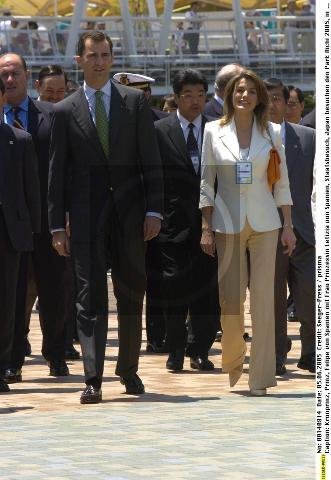 pre-SEEGER00140814.jpg31.5 KB · Views: 226
pre-SEEGER00140814.jpg31.5 KB · Views: 226 -
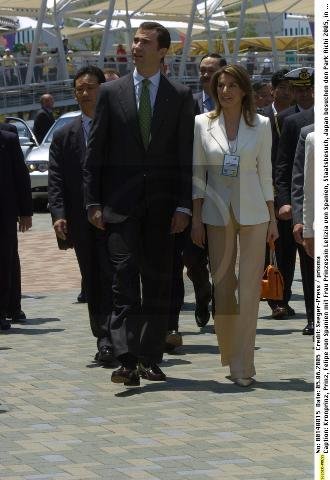 pre-SEEGER00140815.jpg30.3 KB · Views: 308
pre-SEEGER00140815.jpg30.3 KB · Views: 308 -
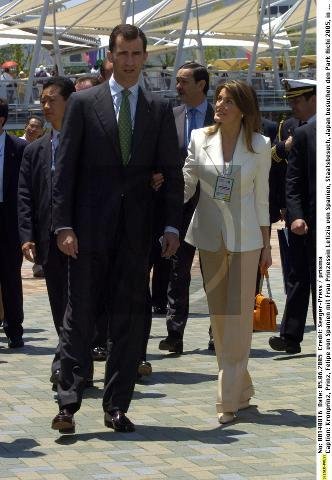 pre-SEEGER00140816.jpg35.1 KB · Views: 248
pre-SEEGER00140816.jpg35.1 KB · Views: 248 -
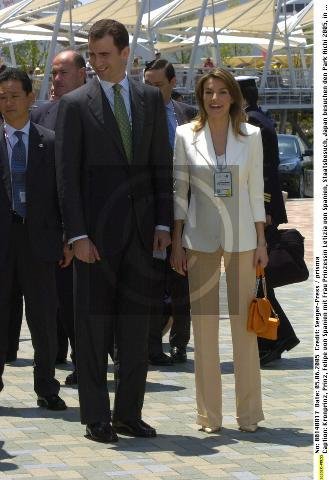 pre-SEEGER00140817.jpg31.4 KB · Views: 230
pre-SEEGER00140817.jpg31.4 KB · Views: 230 -
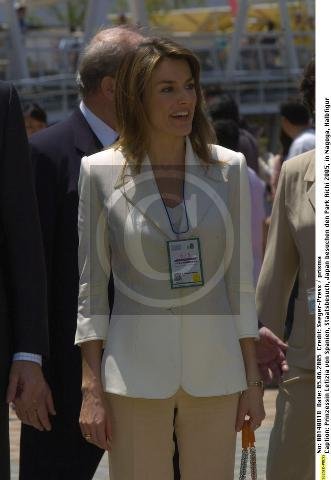 pre-SEEGER00140818.jpg22.2 KB · Views: 211
pre-SEEGER00140818.jpg22.2 KB · Views: 211 -
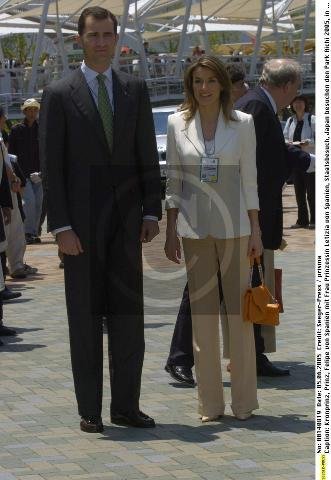 pre-SEEGER00140819.jpg29.9 KB · Views: 208
pre-SEEGER00140819.jpg29.9 KB · Views: 208 -
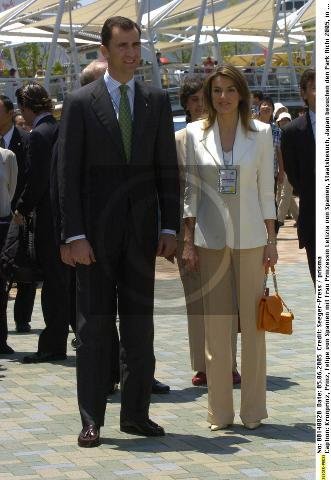 pre-SEEGER00140820.jpg33.1 KB · Views: 325
pre-SEEGER00140820.jpg33.1 KB · Views: 325 -
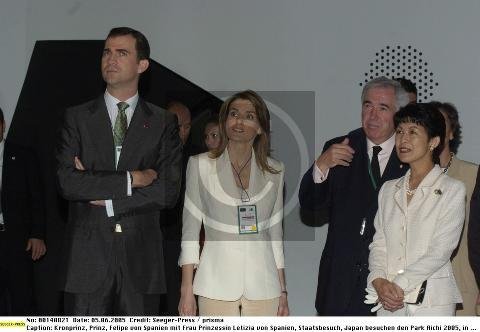 pre-SEEGER00140821.jpg23 KB · Views: 290
pre-SEEGER00140821.jpg23 KB · Views: 290 -
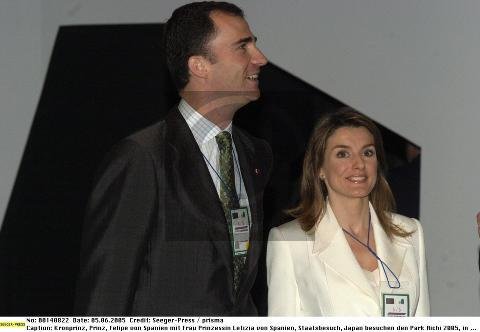 pre-SEEGER00140822.jpg18.4 KB · Views: 312
pre-SEEGER00140822.jpg18.4 KB · Views: 312 -
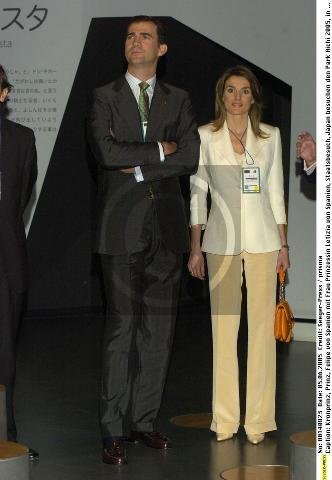 pre-SEEGER00140823.jpg22.8 KB · Views: 298
pre-SEEGER00140823.jpg22.8 KB · Views: 298
lucys
Courtier
- Joined
- Dec 31, 2003
- Messages
- 993
More from Seegergrass
Attachments
-
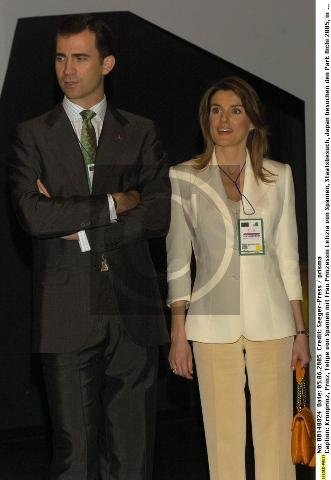 pre-SEEGER00140824.jpg22.2 KB · Views: 224
pre-SEEGER00140824.jpg22.2 KB · Views: 224 -
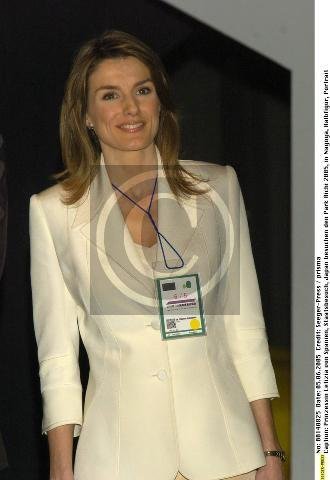 pre-SEEGER00140825.jpg20.1 KB · Views: 233
pre-SEEGER00140825.jpg20.1 KB · Views: 233 -
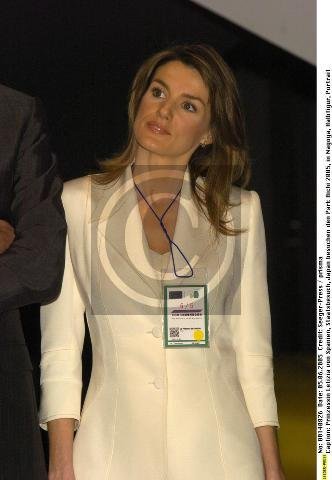 pre-SEEGER00140826.jpg21.4 KB · Views: 249
pre-SEEGER00140826.jpg21.4 KB · Views: 249 -
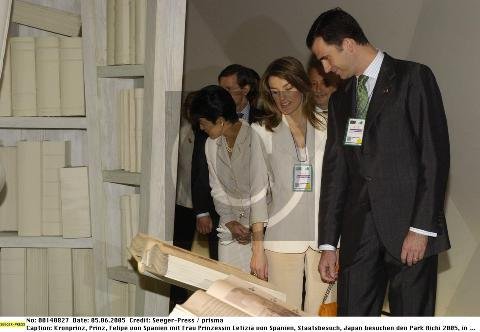 pre-SEEGER00140827.jpg25.2 KB · Views: 320
pre-SEEGER00140827.jpg25.2 KB · Views: 320 -
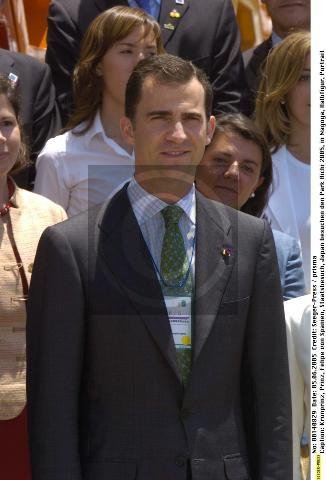 pre-SEEGER00140829.jpg24 KB · Views: 300
pre-SEEGER00140829.jpg24 KB · Views: 300 -
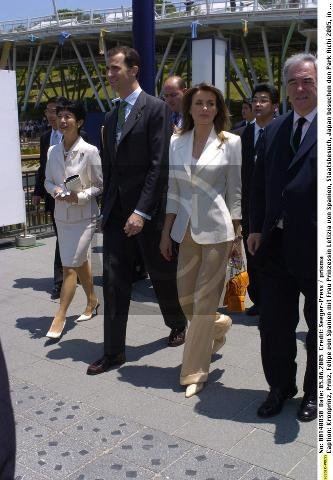 pre-SEEGER00140830.jpg34.9 KB · Views: 212
pre-SEEGER00140830.jpg34.9 KB · Views: 212 -
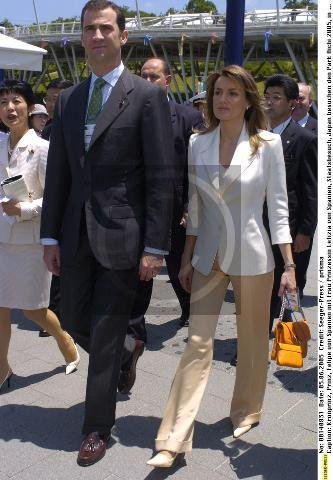 pre-SEEGER00140831.jpg34.1 KB · Views: 238
pre-SEEGER00140831.jpg34.1 KB · Views: 238 -
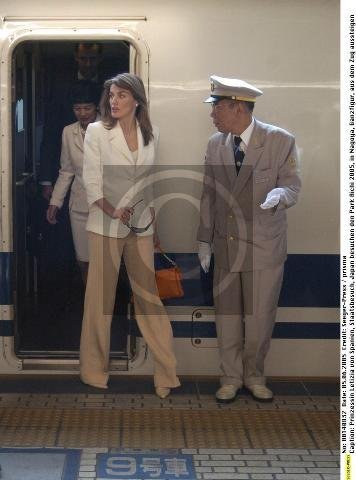 pre-SEEGER00140832.jpg25.6 KB · Views: 246
pre-SEEGER00140832.jpg25.6 KB · Views: 246 -
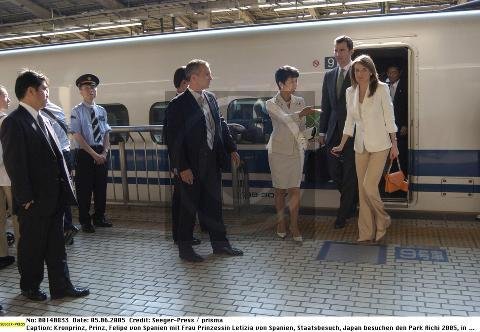 pre-SEEGER00140833.jpg34.5 KB · Views: 321
pre-SEEGER00140833.jpg34.5 KB · Views: 321 -
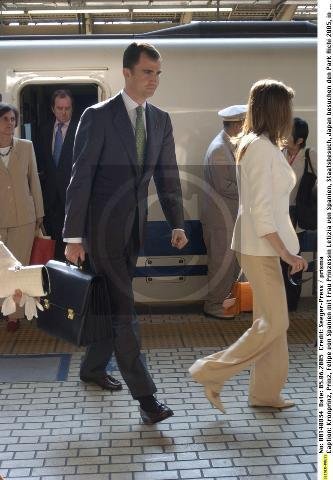 pre-SEEGER00140834.jpg32 KB · Views: 297
pre-SEEGER00140834.jpg32 KB · Views: 297
mandyy
Heir Presumptive
- Joined
- Oct 4, 2004
- Messages
- 2,615
- Country
- Canada
Schieffer to represent U.S. on emperor's trip to Saipan
Sunday, June 5, 2005 at 06:15 JST
WASHINGTON — U.S. Ambassador to Japan Thomas Schieffer will receive Emperor Akihito and Empress Michiko during their June 27-28 trip to Saipan as the U.S. government representative, a U.S. official said Saturday.
Along with Schieffer, Rust Deming, former deputy chief of mission at the U.S. Embassy in Tokyo, will be sent to the western Pacific island as the State Department representative, the official said. (Kyodo News)
Sunday, June 5, 2005 at 06:15 JST
WASHINGTON — U.S. Ambassador to Japan Thomas Schieffer will receive Emperor Akihito and Empress Michiko during their June 27-28 trip to Saipan as the U.S. government representative, a U.S. official said Saturday.
Along with Schieffer, Rust Deming, former deputy chief of mission at the U.S. Embassy in Tokyo, will be sent to the western Pacific island as the State Department representative, the official said. (Kyodo News)
Last edited by a moderator:
mandyy
Heir Presumptive
- Joined
- Oct 4, 2004
- Messages
- 2,615
- Country
- Canada
mandyy
Heir Presumptive
- Joined
- Oct 4, 2004
- Messages
- 2,615
- Country
- Canada
Emir of Qatar Sheikh Hamad bin Khalifa al-Thani and his wife Sheikha Mozah bint Nasser Abdullah al-Misnad are welcomed by Japan's Emperor Akihito and Empress Michiko at the Imperial Palace in Tokyo June 9, 2005. Al-Thani is in Japan on a three-day visit.
Thursday June 9, 5:42 PM
Emperor meets with Qatari emir
(Kyodo) _ Emperor Akihito and Empress Michiko met with Qatari Emir Hamad bin Khalifa Al Thani and his wife at the Imperial Palace on Thursday, Japanese government officials said.
Responding to a question from Hamad about how Japan has dealt with environmental problems, the emperor said, "There were times when economic growth resulted in deterioration in the environment and people's lives. It's necessary to overcome the environmental problems that the public is aware of and work for solutions."
Crown Prince Naruhito and other imperial family members later joined a luncheon with the emir.
Hamad also visited the crown prince's residence to see his wife Crown Princess Masako and their daughter Aiko. Qatar is a major supplier of crude oil to Japan.
Thursday June 9, 5:42 PM
Emperor meets with Qatari emir
(Kyodo) _ Emperor Akihito and Empress Michiko met with Qatari Emir Hamad bin Khalifa Al Thani and his wife at the Imperial Palace on Thursday, Japanese government officials said.
Responding to a question from Hamad about how Japan has dealt with environmental problems, the emperor said, "There were times when economic growth resulted in deterioration in the environment and people's lives. It's necessary to overcome the environmental problems that the public is aware of and work for solutions."
Crown Prince Naruhito and other imperial family members later joined a luncheon with the emir.
Hamad also visited the crown prince's residence to see his wife Crown Princess Masako and their daughter Aiko. Qatar is a major supplier of crude oil to Japan.
Attachments
Last edited:
mandyy
Heir Presumptive
- Joined
- Oct 4, 2004
- Messages
- 2,615
- Country
- Canada
[size=+2]Japanese royals stub out custom of giving cigarettes[/size]
TOKYO: Japan's imperial palace will end a century-old custom of presenting gifts of cigarettes bearing the royal Chrysanthemum emblem to officials, staff and palace volunteers, bowing to global efforts to discourage smoking.
Traditionally, the cigarettes, which are marked with a golden 16-petal Chrysan-themum, used to be given to soldiers heading off to war or to those injured in battle.
In more modern times, however, they have been presented to volunteers who tend the palace gardens or to local officials, both Japanese and foreign, involved in visits by Emperor Akihito and Empress Michiko.
“The custom of giving cigarettes will end in March 2007,” a spokesman at the Imperial Household Agency said yesterday.
“This reflects the trend of the time,” he said. “The smoking rate is falling and people are talking about the harms of smoking.”
Japan Tobacco Inc said it began producing the current type of royal cigarettes, which are made from locally-grown tobacco, in 1934.
Supply to the palace peaked in 1944, the year before Japan's World War II surrender, with 28 million cigarettes and cigars produced as royal gifts or for palace guests, according to Japan Tobacco.
But the supply has since plunged to 1.4 million cigarettes a year.
The company, which is Japan's sole cigarette producer, said it regretted the palace's decision.
“It is very regrettable historically and culturally as there are still people who are happy to have the gift cigarettes,” spokesman Kazunori Hayashi said.
The percentage of Japanese adults who smoke fell to a record low of 29.4%, according to a survey released last October by Japan Tobacco. Akihito is not known to smoke. He had surgery for prostate cancer in January 2003. – AFP
TOKYO: Japan's imperial palace will end a century-old custom of presenting gifts of cigarettes bearing the royal Chrysanthemum emblem to officials, staff and palace volunteers, bowing to global efforts to discourage smoking.
Traditionally, the cigarettes, which are marked with a golden 16-petal Chrysan-themum, used to be given to soldiers heading off to war or to those injured in battle.
In more modern times, however, they have been presented to volunteers who tend the palace gardens or to local officials, both Japanese and foreign, involved in visits by Emperor Akihito and Empress Michiko.
“The custom of giving cigarettes will end in March 2007,” a spokesman at the Imperial Household Agency said yesterday.
“This reflects the trend of the time,” he said. “The smoking rate is falling and people are talking about the harms of smoking.”
Japan Tobacco Inc said it began producing the current type of royal cigarettes, which are made from locally-grown tobacco, in 1934.
Supply to the palace peaked in 1944, the year before Japan's World War II surrender, with 28 million cigarettes and cigars produced as royal gifts or for palace guests, according to Japan Tobacco.
But the supply has since plunged to 1.4 million cigarettes a year.
The company, which is Japan's sole cigarette producer, said it regretted the palace's decision.
“It is very regrettable historically and culturally as there are still people who are happy to have the gift cigarettes,” spokesman Kazunori Hayashi said.
The percentage of Japanese adults who smoke fell to a record low of 29.4%, according to a survey released last October by Japan Tobacco. Akihito is not known to smoke. He had surgery for prostate cancer in January 2003. – AFP
Attachments
Last edited:
mandyy
Heir Presumptive
- Joined
- Oct 4, 2004
- Messages
- 2,615
- Country
- Canada
The Emperor and Empress visits the Kingdom of Children's nature park in Yokohama on June 9, 2005.
Attachments
-
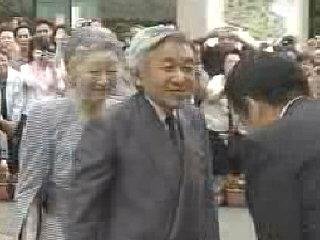 20050609-00000036-jnn-soci-thumb-000.jpg14.5 KB · Views: 586
20050609-00000036-jnn-soci-thumb-000.jpg14.5 KB · Views: 586 -
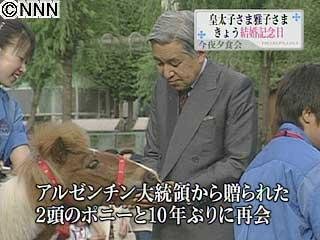 20050609-00000043-nnn-soci-thumb-001.jpg18.5 KB · Views: 539
20050609-00000043-nnn-soci-thumb-001.jpg18.5 KB · Views: 539 -
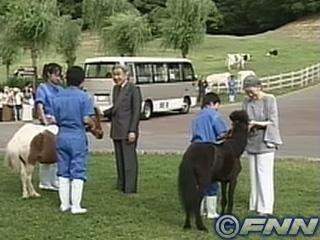 20050609-00000508-fnn-soci-thumb-000.jpg17.2 KB · Views: 511
20050609-00000508-fnn-soci-thumb-000.jpg17.2 KB · Views: 511 -
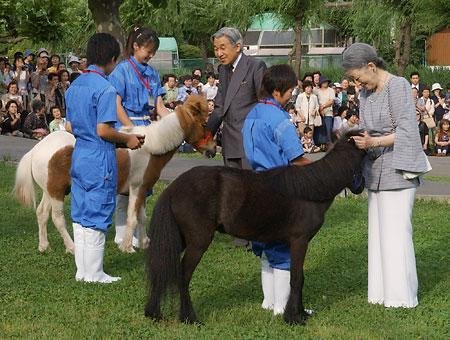 20050609-02512490-jijp-soci-view-001.jpg40.8 KB · Views: 291
20050609-02512490-jijp-soci-view-001.jpg40.8 KB · Views: 291 -
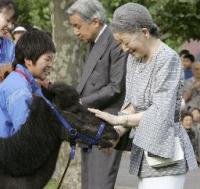 20050609-00000157-kyodo-soci-thum-000.jpg9.2 KB · Views: 450
20050609-00000157-kyodo-soci-thum-000.jpg9.2 KB · Views: 450
mandyy
Heir Presumptive
- Joined
- Oct 4, 2004
- Messages
- 2,615
- Country
- Canada
Prince and Princess Takamado
1.May 10, 1998 at the wedding of Infanta Cristina
2.US First Lady Laura Bush (C) reads "Curious George" for second grade school children through an interpreter (L,unidentified), at Akashi Elementary School in Tokyo, 18 February 2002. At right is Japanese Princess Hisako.
3. Feb 18, 2002.
4-5. Japan's Prince Takamado and his wife, Princess Hisako, wave 29 May 2002 upon their arrival at Incheon airport. The Japanese couple arrive here for a six-day visit to the 2002 FIFA World Cup Korea/Japan finals.
6-7. Japan's Princess Hiseko and her husband, Prince Takamado, visit the national cemetery in Seoul 29 May 2002.
8-9.Japan's Prince Takamado , a cousin of Emperor Akihito, accompanied by his wife Princess Hisako, tour Chang-Duck Goong, an old palace in Seoul, 30 May 2002.
10.Japan's Prince Takamado and his wife Princess Hisako wave from their car May 29, 2002 on their way to Seoul, South Korea
1.May 10, 1998 at the wedding of Infanta Cristina
2.US First Lady Laura Bush (C) reads "Curious George" for second grade school children through an interpreter (L,unidentified), at Akashi Elementary School in Tokyo, 18 February 2002. At right is Japanese Princess Hisako.
3. Feb 18, 2002.
4-5. Japan's Prince Takamado and his wife, Princess Hisako, wave 29 May 2002 upon their arrival at Incheon airport. The Japanese couple arrive here for a six-day visit to the 2002 FIFA World Cup Korea/Japan finals.
6-7. Japan's Princess Hiseko and her husband, Prince Takamado, visit the national cemetery in Seoul 29 May 2002.
8-9.Japan's Prince Takamado , a cousin of Emperor Akihito, accompanied by his wife Princess Hisako, tour Chang-Duck Goong, an old palace in Seoul, 30 May 2002.
10.Japan's Prince Takamado and his wife Princess Hisako wave from their car May 29, 2002 on their way to Seoul, South Korea
Attachments
-
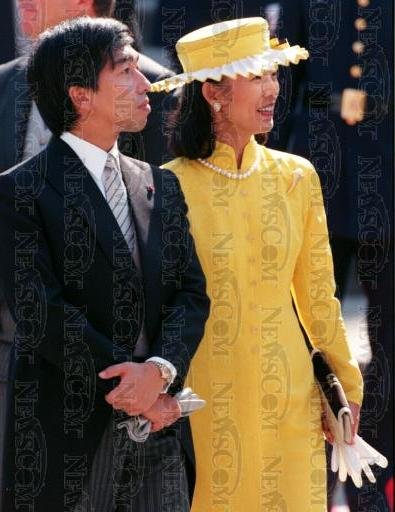 rtrphotos367161.jpg35.9 KB · Views: 304
rtrphotos367161.jpg35.9 KB · Views: 304 -
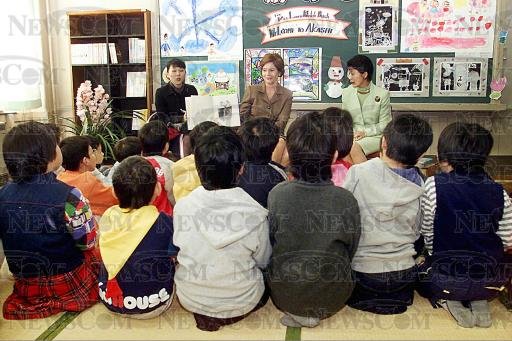 afpphotos431887.jpg45.5 KB · Views: 209
afpphotos431887.jpg45.5 KB · Views: 209 -
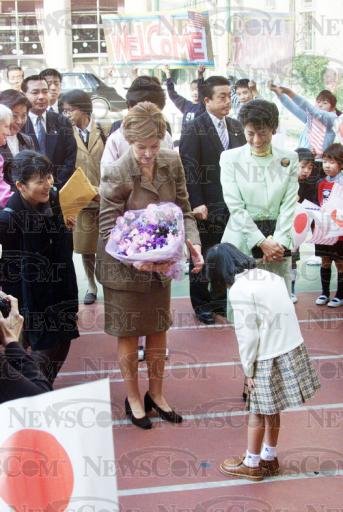 gettypix258700.jpg38.2 KB · Views: 270
gettypix258700.jpg38.2 KB · Views: 270 -
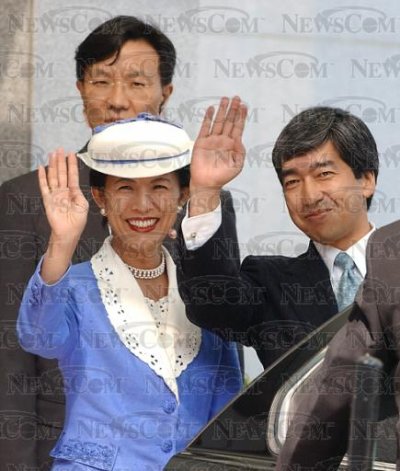 korea.jpg40.1 KB · Views: 233
korea.jpg40.1 KB · Views: 233 -
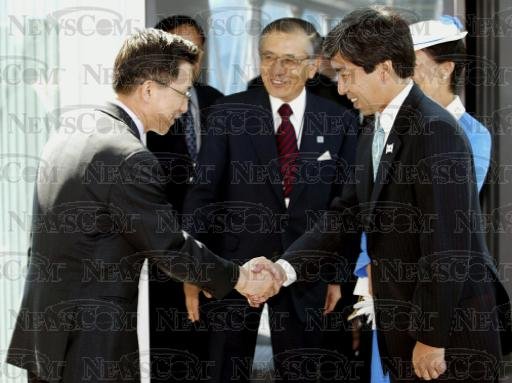 korean.jpg34.4 KB · Views: 304
korean.jpg34.4 KB · Views: 304 -
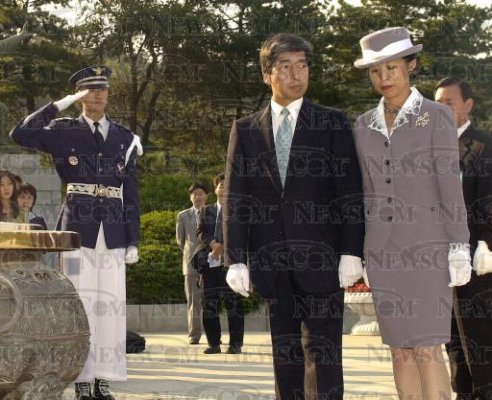 korea1.jpg48.7 KB · Views: 305
korea1.jpg48.7 KB · Views: 305 -
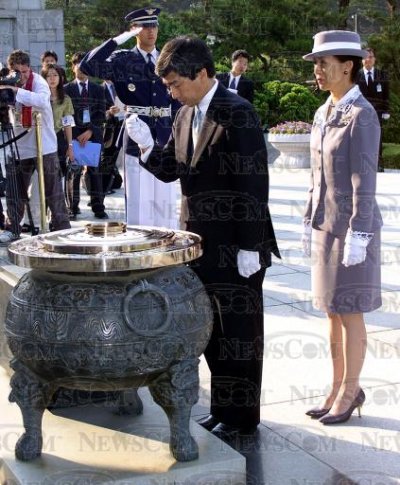 korea2.jpg53.1 KB · Views: 276
korea2.jpg53.1 KB · Views: 276 -
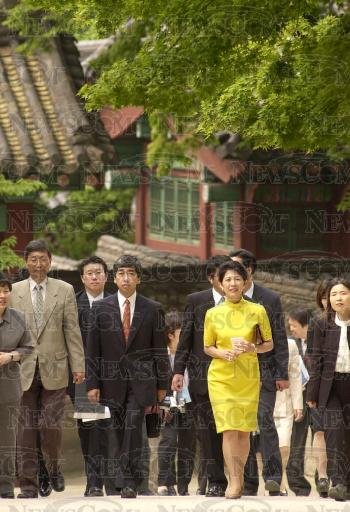 palace.jpg40.9 KB · Views: 202
palace.jpg40.9 KB · Views: 202 -
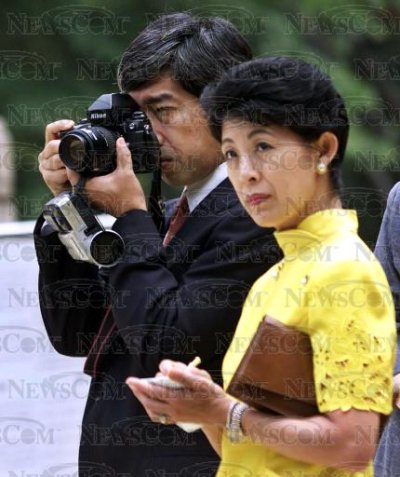 palace1.jpg40 KB · Views: 274
palace1.jpg40 KB · Views: 274 -
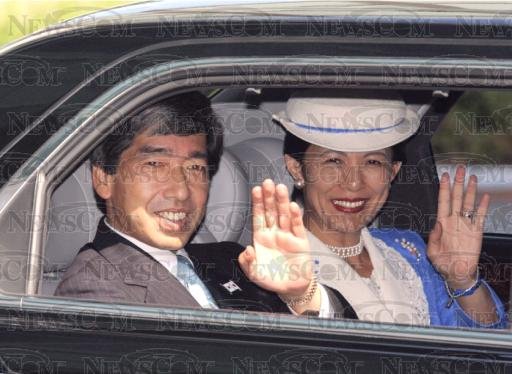 airport.jpg36.6 KB · Views: 267
airport.jpg36.6 KB · Views: 267
mandyy
Heir Presumptive
- Joined
- Oct 4, 2004
- Messages
- 2,615
- Country
- Canada
More photos
1.Heading to Korea from Japan June 3, 2002.
2.Japan's Prince Takamado and his wife Princess Hisako speak to the press in Pusan, South Korea June 2 before winding up their visit to South Korea.
3.Japanese Prince Takamado (2nd from R) and his wife Princess Hisako (3rd from R) visit Myong Hie Won, a facility for the handicapped outside Seoul on May 31. It was established mainly by Lee Masako, who was from the Japanese imperial family and later married the late Korean Prince Lee Un.
4.Japan's Prince Takamado and his wife Princess Hisako, in South Korea to attend the World Cup finals' opening ceremony, watch a student work with a computer on a visit to a primary school May 30 in Seoul.
5-6.Japanese Prince Takamado (L), cousin of Emperor Akihito and Princess Hisako (R), watch a 2002 Federation Internationale de Football Association (FIFA) World Cup match between Japan and Tunisia at Nagai Stadium June 14, 2002 in Osaka, Japan.
7.Princess Astrid and Prince Lorenz met Prince and Princess Takamado at the Belgian Embassy in Tokyo on October 13, 2000.
8.Argentina's Boca Juniors defender Jorge Hernan Bermudez raises the Intercontinental Cup as Boca Juniors defeated Spain's Real Madrid during the Toyota Cup, Europe/South America football club championship in Tokyo, 28 November 2000, while Japanese Prince and Princess Takamado celebrate from the podium.
9.Prince Takamado looks on during the FIFA World Cup Finals 2002 Group H match between Japan and Tunisia played at the Osaka-Nagai Stadium, in Osaka, Japan on June 14, 2002.
10. Prince Takamado of Japan during the FIFA World Cup Finals 2002 Second Round match between Japan and Turkey played at the Miyagi Stadium, in Miyagi, Japan on June 18, 2002.
1.Heading to Korea from Japan June 3, 2002.
2.Japan's Prince Takamado and his wife Princess Hisako speak to the press in Pusan, South Korea June 2 before winding up their visit to South Korea.
3.Japanese Prince Takamado (2nd from R) and his wife Princess Hisako (3rd from R) visit Myong Hie Won, a facility for the handicapped outside Seoul on May 31. It was established mainly by Lee Masako, who was from the Japanese imperial family and later married the late Korean Prince Lee Un.
4.Japan's Prince Takamado and his wife Princess Hisako, in South Korea to attend the World Cup finals' opening ceremony, watch a student work with a computer on a visit to a primary school May 30 in Seoul.
5-6.Japanese Prince Takamado (L), cousin of Emperor Akihito and Princess Hisako (R), watch a 2002 Federation Internationale de Football Association (FIFA) World Cup match between Japan and Tunisia at Nagai Stadium June 14, 2002 in Osaka, Japan.
7.Princess Astrid and Prince Lorenz met Prince and Princess Takamado at the Belgian Embassy in Tokyo on October 13, 2000.
8.Argentina's Boca Juniors defender Jorge Hernan Bermudez raises the Intercontinental Cup as Boca Juniors defeated Spain's Real Madrid during the Toyota Cup, Europe/South America football club championship in Tokyo, 28 November 2000, while Japanese Prince and Princess Takamado celebrate from the podium.
9.Prince Takamado looks on during the FIFA World Cup Finals 2002 Group H match between Japan and Tunisia played at the Osaka-Nagai Stadium, in Osaka, Japan on June 14, 2002.
10. Prince Takamado of Japan during the FIFA World Cup Finals 2002 Second Round match between Japan and Turkey played at the Miyagi Stadium, in Miyagi, Japan on June 18, 2002.
Attachments
-
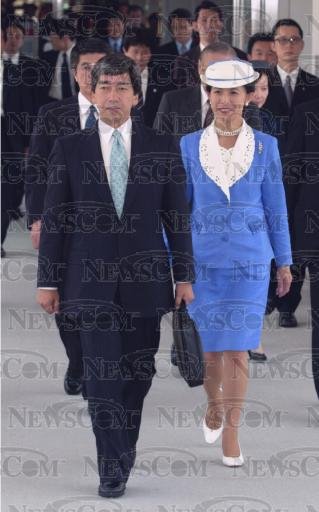 airport1.jpg27.4 KB · Views: 273
airport1.jpg27.4 KB · Views: 273 -
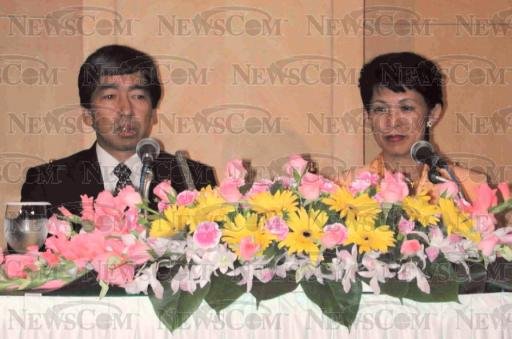 pusan.jpg32.8 KB · Views: 291
pusan.jpg32.8 KB · Views: 291 -
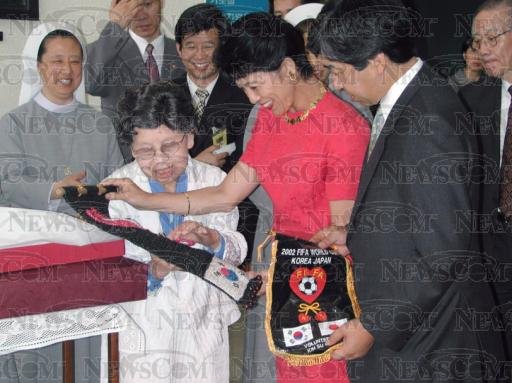 kyodowc000356.jpg38.4 KB · Views: 243
kyodowc000356.jpg38.4 KB · Views: 243 -
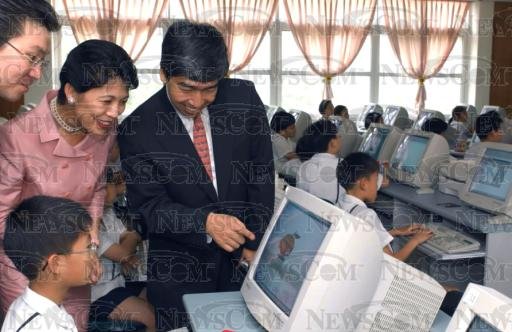 q1.jpg35.5 KB · Views: 280
q1.jpg35.5 KB · Views: 280 -
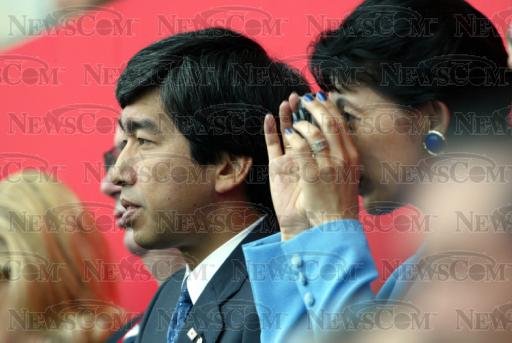 soccer.jpg28.8 KB · Views: 274
soccer.jpg28.8 KB · Views: 274 -
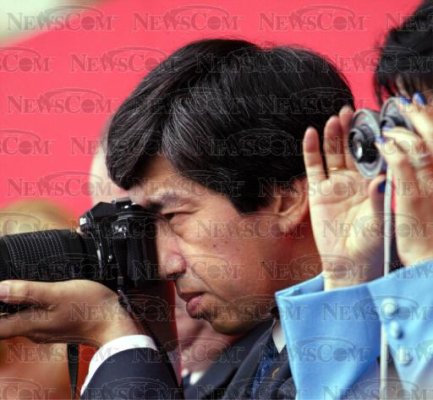 soccer1.jpg42 KB · Views: 247
soccer1.jpg42 KB · Views: 247 -
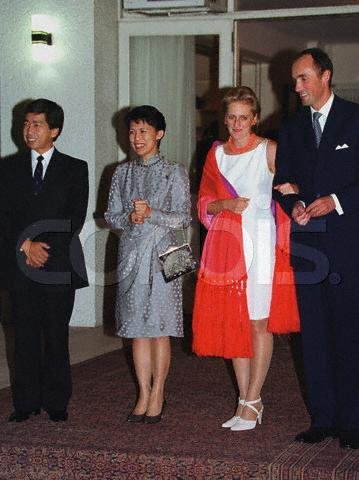 belgium.jpg30.7 KB · Views: 233
belgium.jpg30.7 KB · Views: 233 -
 51498534.jpg54.4 KB · Views: 266
51498534.jpg54.4 KB · Views: 266 -
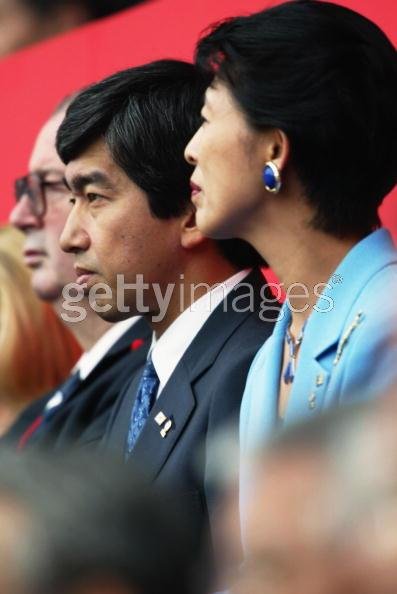 792386.jpg26.7 KB · Views: 263
792386.jpg26.7 KB · Views: 263 -
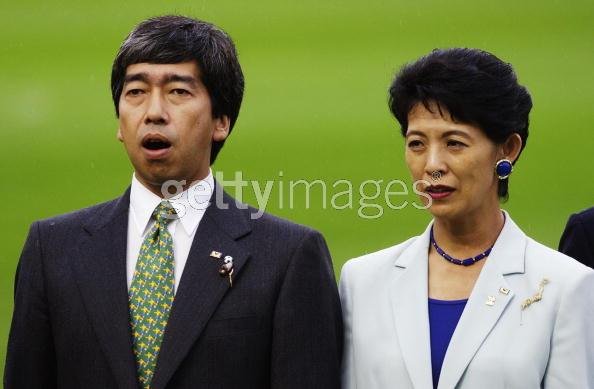 842408.jpg27.3 KB · Views: 344
842408.jpg27.3 KB · Views: 344
mandyy
Heir Presumptive
- Joined
- Oct 4, 2004
- Messages
- 2,615
- Country
- Canada
1. Prince Takamado (L) and his wife, Princess Hisako, outside the Imperial Palace in December l984 after meeting Emperor Hirohito, posthumously called Emperor Showa, following their wedding.
2-4.Japan's Imperial Highness Prince and Princess Takamado view Japanese pottery by artist Tsugio Yasum as they tour an East/West Design Show at the Japanese American Cultural and Community Center on December 13, 1997 in Los Angeles.
5-7.Japan's Prince and Princess Takamado listen to an explanation during the royal couple's visit to the Japanese soccer team's training camp in Aix-les-Bains on June 16, 1998.
8.Prince Takamado (2nd from L) and his wife Hisako (L) visited Nagano in central Japan in February 1998 to watch a Nagano Winter Olympics event.
9.Japanese Prince Takamado, cousin of Emperor Akihito, left, and Princess Hisako are accompanied by FIFA President Sepp Blatter at a ceremony prior to the kick off of the 2002 World Cup Group H match between Japan and Russia in Yokohama, Japan, Sunday, June 9, 2002.
10. undated photo of the Takamado family
2-4.Japan's Imperial Highness Prince and Princess Takamado view Japanese pottery by artist Tsugio Yasum as they tour an East/West Design Show at the Japanese American Cultural and Community Center on December 13, 1997 in Los Angeles.
5-7.Japan's Prince and Princess Takamado listen to an explanation during the royal couple's visit to the Japanese soccer team's training camp in Aix-les-Bains on June 16, 1998.
8.Prince Takamado (2nd from L) and his wife Hisako (L) visited Nagano in central Japan in February 1998 to watch a Nagano Winter Olympics event.
9.Japanese Prince Takamado, cousin of Emperor Akihito, left, and Princess Hisako are accompanied by FIFA President Sepp Blatter at a ceremony prior to the kick off of the 2002 World Cup Group H match between Japan and Russia in Yokohama, Japan, Sunday, June 9, 2002.
10. undated photo of the Takamado family
Attachments
-
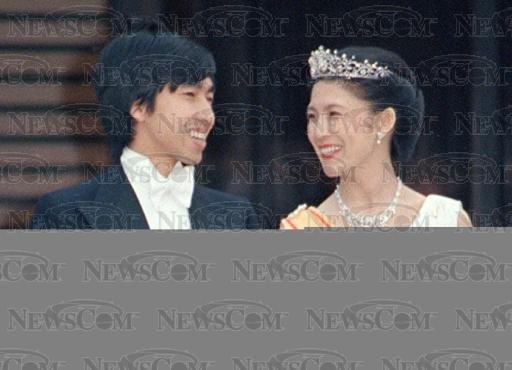 wedding.jpg27.6 KB · Views: 328
wedding.jpg27.6 KB · Views: 328 -
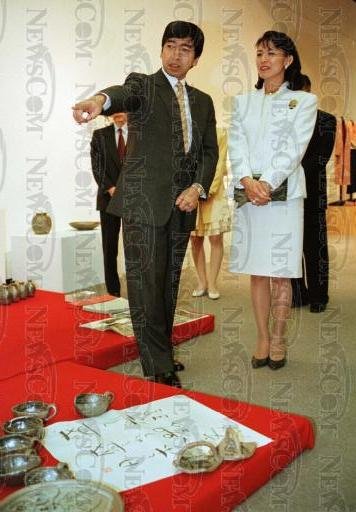 b1.jpg34.1 KB · Views: 256
b1.jpg34.1 KB · Views: 256 -
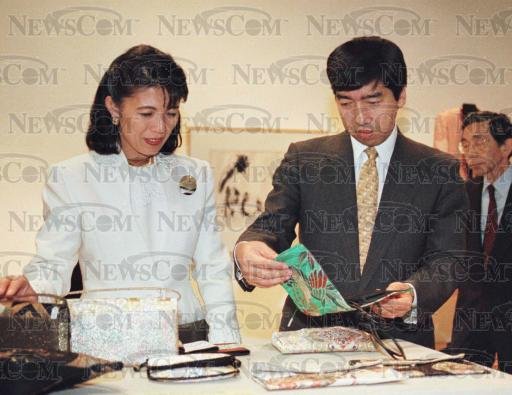 b2.jpg36 KB · Views: 233
b2.jpg36 KB · Views: 233 -
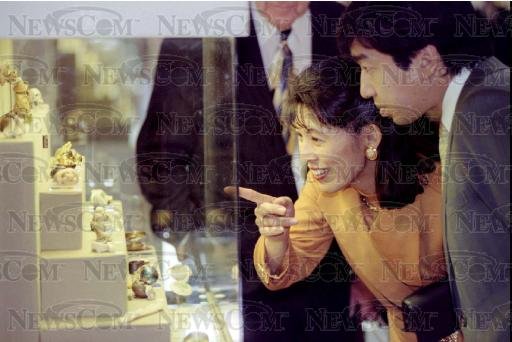 b3.jpg31.8 KB · Views: 380
b3.jpg31.8 KB · Views: 380 -
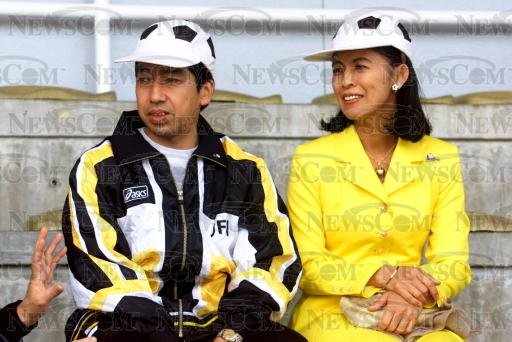 b4.jpg37.1 KB · Views: 315
b4.jpg37.1 KB · Views: 315 -
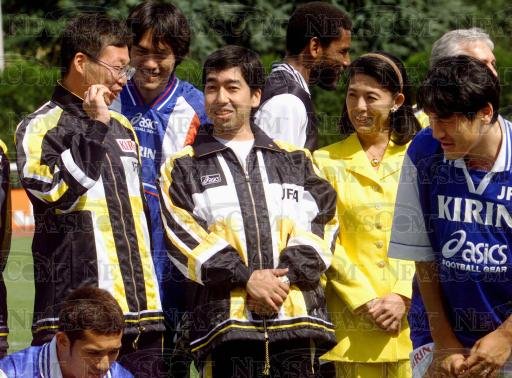 b5.jpg50.2 KB · Views: 265
b5.jpg50.2 KB · Views: 265 -
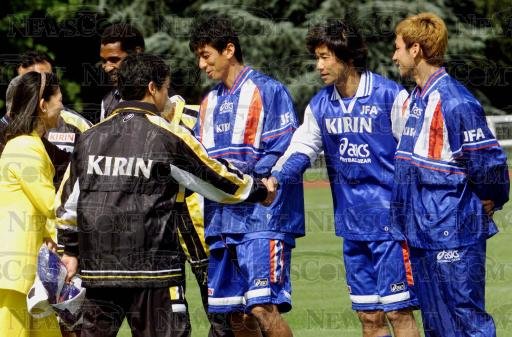 b6.jpg46.8 KB · Views: 242
b6.jpg46.8 KB · Views: 242 -
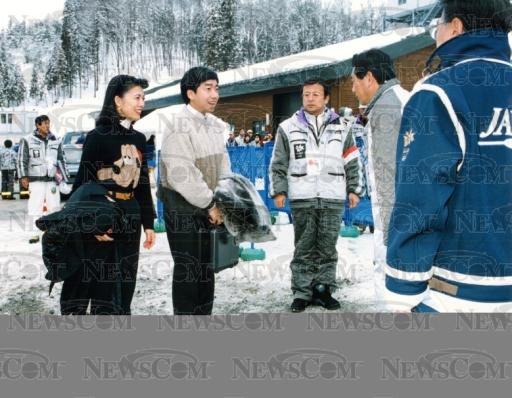 b7.jpg43.7 KB · Views: 281
b7.jpg43.7 KB · Views: 281 -
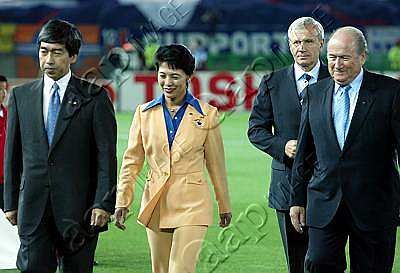 WCUPJPN RUS SOC WCYOK111.jpg19.5 KB · Views: 532
WCUPJPN RUS SOC WCYOK111.jpg19.5 KB · Views: 532 -
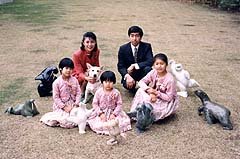 03ph-99.jpg20.5 KB · Views: 590
03ph-99.jpg20.5 KB · Views: 590
mandyy
Heir Presumptive
- Joined
- Oct 4, 2004
- Messages
- 2,615
- Country
- Canada
Japanese Empress Michiko puts silkworms onto beds to make cocoons at the Imperial Palace in Tokyo 10 June 2005. It is part of Japanese tradition that the Empress raises silkworms for sericulture, and some of this silk is used in the revival of old textile materials of historical value.
Attachments
mandyy
Heir Presumptive
- Joined
- Oct 4, 2004
- Messages
- 2,615
- Country
- Canada
The newest issue of the "Our Imperial Family" Magazine.
You can go to the following website and it has the english table of contents at the bottom of the page.
http://www.fusosha.co.jp/imperial/
You can go to the following website and it has the english table of contents at the bottom of the page.
http://www.fusosha.co.jp/imperial/
Attachments
ladybelline
Courtier
- Joined
- Oct 15, 2004
- Messages
- 603
- City
- n
- Country
- France
Here is an article I found quite interesting, about the Succession Law in Japan, and its future.
http://japantoday.com/e/?content=comment&id=788 (link coming from Archivesgotha)
Reigning empress just a matter of time
Shinya Ajima and Miya Tanaka
The Japanese public knows little about what the government panel on imperial succession is discussing. But the people, whether interested or not, will witness a historic change in the world's oldest hereditary monarchy when the panel releases a key report in a few months.
The panel, established in January, has been tasked with discussing whether to allow a female to ascend the throne in light of the fact that no male child has been born to the imperial family in the past 40 years.
At the center of the 10-member panel's discussion is whether to revise the Imperial House Law, which stipulates that only male heirs can succeed to the Imperial Throne.
Analysts believe the panel reaching a decision in favor of revising the law is a foregone conclusion. They add Japan having a female monarch is simply a matter of time.
The panel meets only once or twice in month despite its mission of compiling a proposal for Prime Minister Junichiro Koizumi, possibly in several months. In addition, it includes only a few experts on imperial household affairs.
This has spawned speculation that the panel is just playing for time while floating a trial balloon to assess public sentiment on the sensitive issue of whether to enable female imperial family members to ascend the throne.
"We are discussing the issue from perspectives of Japanese citizens," said Hiroyuki Yoshikawa, a former president of the University of Tokyo, who heads the panel.
"We will focus on ways to ensure a stable imperial succession," Yoshikawa, also a specialist of robotics, said after the panel first met in January.
Japan's imperial system dates back to the fifth century and has been perpetuated in a male line of descent, with eight female monarchs between the sixth and 18th centuries among Japan's 125 emperors including legendary ones.
But the eight women, two of whom reigned twice under different names, existed before the law went into force in 1947. The law mandates that only male heirs who have emperors on their father's side can succeed to the throne.
Historians say most of those reigning empresses have emperors on their father's side, and that their ascensions resulted from emergency situations, such as when a crown prince was too young to reign or was forced to postpone enthronement for political reasons.
The scarcity of male successors in the current imperial family has increasingly exposed 3-year-old Princess Aiko, the only child of Crown Prince Naruhito, 45, and Crown Princess Masako, 41, to intense public attention as a possible future reigning empress.
If the Imperial House Law is revised and Princess Aiko gives birth to a child whose father is a commoner, the child may become the first monarch in Japan who has no emperors on his or her father's side for more than a thousand years, in what historians see as having a critical impact on Japan's history.
"We are firmly resolved to make history," Yoshikawa said in a news conference in January.
In February, speculation that the panel is set to propose a revision to the law intensified as a government source said Princess Aiko will be second in line to the Imperial Throne after her father.
The source said the focus of panel debate is whether Princess Aiko's future children, be they male or female, should be allowed to ascend the throne.
Having such children ascend the throne would have significant impact on the history of the imperial family because that would mean a departure from the tradition of allowing only heirs who have emperors on their father's side to succeed to the throne.
After the comments were disclosed to the general public by news media the following day, Chief Cabinet Secretary Hiroyuki Hosoda said nothing has been determined on Princess Akio's future status, adding all options are open.
At the third meeting of the panel in March, its members agreed that the male-dominant imperial succession being favored historically cannot be backed by any particular documents.
"There are no proper historical documents that clearly explain why the male line has been favored," Yoshikawa said.
In May, panel members acknowledged they are studying the feasibility of five options being presented by the government as models of a new imperial succession system.
Four of the five proposed allowing a female to ascend the throne under certain conditions while the fifth option calls for the current system of preserving a male line to be maintained.
The revision to the Imperial House Law would allow the Imperial Household Agency, which is responsible for the personal, ceremonial and official affairs of the imperial family, to start educating Princess Aiko to prepare her for becoming a monarch.
Analysts say the princess is not too young to start receiving such education.
One of the four options in support of female monarchs is designed to give precedence in imperial succession to the emperor's firstborn regardless of sex.
In the remaining three options, however, males are given precedence over females in ascending the throne, which spawned speculation that the government is still looking for ways to preserve the male-dominant line in the event that the crown prince and princess eventually have a son, analysts say.
Despite the perceived efforts being made by the government to preserve a male line, analysts believe the panel is likely to reach a decision to revise the law.
"We can easily guess how the panel will conclude its discussion," said Yasuhiro Okudaira, a professor emeritus at the University of Tokyo, who specializes in the Constitution.
But he is critical of the recent developments surrounding imperial succession, saying the general public would be wrong if they blindly opt to enable females to succeed to the throne just to maintain the imperial system.
"People should discuss the question of whether the imperial system itself should be kept intact before they discuss if a female monarch is to be allowed," Okudaira said.
Some people in Japan are strongly opposed to the continued maintenance of the imperial system, saying it was responsible for Japanese militarism during World War II.
An opinion poll released in March showed 81% of the general public supports revising the law to allow a female successor to ascend the throne against 5% who want to see the male-dominant line sustained.
The finding represented a remarkable shift from a similar survey in 1975, which found 54% were against a reigning empress, while 31% supported gender equality.
Hidehiko Kasahara, a professor at Keio University, suggested the panel most fears its conclusion deviating from the sentiment of the general public.
"The panel is on a course to reaching a conclusion which is not far away from the average public opinion," said Kasahara, who teaches Japanese political history.
"In addition there is no doubt they cannot help but think of, first of all, allowing a female monarch due to lack of male heirs," he said.
In the last two sessions May 31 and June 8, the panel invited a total of eight experts on imperial household affairs to hear their opinions on the succession issue.
Some of the experts proposed the government maintain the current male-dominant system by arguing, for example, that Japanese tradition needs to be protected, the majority insisted reigning empresses be allowed for the sake of the imperial family's survival.
Hiroshi Takahashi, a professor at Shizuoka University of Welfare, who was invited to express his views, said before joining the panel that the general public may think the panel is hastily reaching a foregone conclusion.
"But I actually don't know whether the panel could win support from the public for a conclusion without process," said Takahashi, who argued for successions by firstborns. (Kyodo News)
June 11, 2005
http://japantoday.com/e/?content=comment&id=788 (link coming from Archivesgotha)
Reigning empress just a matter of time
Shinya Ajima and Miya Tanaka
The Japanese public knows little about what the government panel on imperial succession is discussing. But the people, whether interested or not, will witness a historic change in the world's oldest hereditary monarchy when the panel releases a key report in a few months.
The panel, established in January, has been tasked with discussing whether to allow a female to ascend the throne in light of the fact that no male child has been born to the imperial family in the past 40 years.
At the center of the 10-member panel's discussion is whether to revise the Imperial House Law, which stipulates that only male heirs can succeed to the Imperial Throne.
Analysts believe the panel reaching a decision in favor of revising the law is a foregone conclusion. They add Japan having a female monarch is simply a matter of time.
The panel meets only once or twice in month despite its mission of compiling a proposal for Prime Minister Junichiro Koizumi, possibly in several months. In addition, it includes only a few experts on imperial household affairs.
This has spawned speculation that the panel is just playing for time while floating a trial balloon to assess public sentiment on the sensitive issue of whether to enable female imperial family members to ascend the throne.
"We are discussing the issue from perspectives of Japanese citizens," said Hiroyuki Yoshikawa, a former president of the University of Tokyo, who heads the panel.
"We will focus on ways to ensure a stable imperial succession," Yoshikawa, also a specialist of robotics, said after the panel first met in January.
Japan's imperial system dates back to the fifth century and has been perpetuated in a male line of descent, with eight female monarchs between the sixth and 18th centuries among Japan's 125 emperors including legendary ones.
But the eight women, two of whom reigned twice under different names, existed before the law went into force in 1947. The law mandates that only male heirs who have emperors on their father's side can succeed to the throne.
Historians say most of those reigning empresses have emperors on their father's side, and that their ascensions resulted from emergency situations, such as when a crown prince was too young to reign or was forced to postpone enthronement for political reasons.
The scarcity of male successors in the current imperial family has increasingly exposed 3-year-old Princess Aiko, the only child of Crown Prince Naruhito, 45, and Crown Princess Masako, 41, to intense public attention as a possible future reigning empress.
If the Imperial House Law is revised and Princess Aiko gives birth to a child whose father is a commoner, the child may become the first monarch in Japan who has no emperors on his or her father's side for more than a thousand years, in what historians see as having a critical impact on Japan's history.
"We are firmly resolved to make history," Yoshikawa said in a news conference in January.
In February, speculation that the panel is set to propose a revision to the law intensified as a government source said Princess Aiko will be second in line to the Imperial Throne after her father.
The source said the focus of panel debate is whether Princess Aiko's future children, be they male or female, should be allowed to ascend the throne.
Having such children ascend the throne would have significant impact on the history of the imperial family because that would mean a departure from the tradition of allowing only heirs who have emperors on their father's side to succeed to the throne.
After the comments were disclosed to the general public by news media the following day, Chief Cabinet Secretary Hiroyuki Hosoda said nothing has been determined on Princess Akio's future status, adding all options are open.
At the third meeting of the panel in March, its members agreed that the male-dominant imperial succession being favored historically cannot be backed by any particular documents.
"There are no proper historical documents that clearly explain why the male line has been favored," Yoshikawa said.
In May, panel members acknowledged they are studying the feasibility of five options being presented by the government as models of a new imperial succession system.
Four of the five proposed allowing a female to ascend the throne under certain conditions while the fifth option calls for the current system of preserving a male line to be maintained.
The revision to the Imperial House Law would allow the Imperial Household Agency, which is responsible for the personal, ceremonial and official affairs of the imperial family, to start educating Princess Aiko to prepare her for becoming a monarch.
Analysts say the princess is not too young to start receiving such education.
One of the four options in support of female monarchs is designed to give precedence in imperial succession to the emperor's firstborn regardless of sex.
In the remaining three options, however, males are given precedence over females in ascending the throne, which spawned speculation that the government is still looking for ways to preserve the male-dominant line in the event that the crown prince and princess eventually have a son, analysts say.
Despite the perceived efforts being made by the government to preserve a male line, analysts believe the panel is likely to reach a decision to revise the law.
"We can easily guess how the panel will conclude its discussion," said Yasuhiro Okudaira, a professor emeritus at the University of Tokyo, who specializes in the Constitution.
But he is critical of the recent developments surrounding imperial succession, saying the general public would be wrong if they blindly opt to enable females to succeed to the throne just to maintain the imperial system.
"People should discuss the question of whether the imperial system itself should be kept intact before they discuss if a female monarch is to be allowed," Okudaira said.
Some people in Japan are strongly opposed to the continued maintenance of the imperial system, saying it was responsible for Japanese militarism during World War II.
An opinion poll released in March showed 81% of the general public supports revising the law to allow a female successor to ascend the throne against 5% who want to see the male-dominant line sustained.
The finding represented a remarkable shift from a similar survey in 1975, which found 54% were against a reigning empress, while 31% supported gender equality.
Hidehiko Kasahara, a professor at Keio University, suggested the panel most fears its conclusion deviating from the sentiment of the general public.
"The panel is on a course to reaching a conclusion which is not far away from the average public opinion," said Kasahara, who teaches Japanese political history.
"In addition there is no doubt they cannot help but think of, first of all, allowing a female monarch due to lack of male heirs," he said.
In the last two sessions May 31 and June 8, the panel invited a total of eight experts on imperial household affairs to hear their opinions on the succession issue.
Some of the experts proposed the government maintain the current male-dominant system by arguing, for example, that Japanese tradition needs to be protected, the majority insisted reigning empresses be allowed for the sake of the imperial family's survival.
Hiroshi Takahashi, a professor at Shizuoka University of Welfare, who was invited to express his views, said before joining the panel that the general public may think the panel is hastily reaching a foregone conclusion.
"But I actually don't know whether the panel could win support from the public for a conclusion without process," said Takahashi, who argued for successions by firstborns. (Kyodo News)
June 11, 2005
Last edited by a moderator:
mandyy
Heir Presumptive
- Joined
- Oct 4, 2004
- Messages
- 2,615
- Country
- Canada
Tuesday June 14, 4:22 PM
FOCUS: Emperor to visit Saipan amid disputes over Japan's past
(Kyodo) _ Japanese Emperor Akihito and Empress Michiko will visit Saipan on June 27-28 as part of their long-held wish to pay homage to victims at sites of battles between Japan and the United States during World War II.
But the Japanese government is apparently trying to keep the imperial couple's visit to the western Pacific island, which the Japanese military once occupied, low-key against the backdrop of recent disputes between Japan and Asian neighbors over its recognition of war-related issues.
"This time, the visit by the imperial couple is only aimed at expressing condolences to the victims who died in the Battle of Saipan. It will be different from their usual goodwill visits to foreign countries," said an official of the Japanese Consul General's office on Guam, which is near Saipan.
"The tour will be as simple as possible," the Japanese official said.
Saipan was a site of fierce fighting between Japan and the United States in 1944 during the war. Some 43,000 Japanese troops, 12,000 civilians, 5,000 American soldiers and 900 locals died on Saipan and the nearby island of Tinian during the three-week battle from June to July 1944.
Many Japanese soldiers and civilians had moved to the islands after Japan took them over in 1920.
After the United States won the battle, it used both Saipan and Tinian as a base to launch air raids on Japan's main islands. The B-29 bomber that dropped an atomic bomb on Hiroshima took off from Tinian.
Peter Callaghan, the press secretary for Gov. Juan Babuta of the U.S. Commonwealth of Northern Mariana Islands, said, "We understand the solemnity of their visit...but at the same time we are anxious to show the beautiful island of Saipan to the people of Japan." "And now we are proud to show the transformation Saipan has undergone in the past 60 years. We will welcome Their Majesties with open arms," Callaghan said in a written comment.
The imperial couple's visit to Saipan, which coincides with the 60th anniversary in 2005 of the end of World War II, is part of their visits to locations related with war. They have already visited Hiroshima, Nagasaki, Okinawa and Iwojima Island.
Saipan will be the first foreign destination the imperial couple will visit solely for the purpose of expressing condolences to war victims.
The couple have a strong desire to visit Saipan as no imperial family members have ever done so, according to the Imperial Household Agency. Their hope has strengthened especially after a plan to visit the area was canceled last year for security reasons.
During the visit, they are scheduled to pay a visit to a monument the Japanese government erected in 1974, a memorial park for American soldiers and a cultural facility for the aged, where they will talk with local people.
The emperor and empress are also expected to see cliffs on the island from which hundreds of Japanese soldiers and civilians jumped to their deaths after refusing to surrender.
One of the cliffs, now a famous tourist spot, is called Banzai Cliff, which was named after those Japanese who committed suicide while shouting the traditional "banzai" (long live) cheer for the late Emperor Hirohito. The late emperor, who headed the Japanese military during the war, was the father of the present emperor.
Before Japan's defeat in the war, it was decreed that the emperor was all powerful and descended from gods.
In 1946, however, Emperor Hirohito, known posthumously as Emperor Showa, denied his divinity and was innocuously given a position as "the symbol of state" under the postwar Constitution, rather than being held responsible for the war at a tribunal.
The visit to Saipan will come amid tense relations between Japan and its Asian neighbors over war-related issues including recognition of history by Japanese leaders.
China and South Korea in particular have bitter memories of then Japanese military's colonial rule and have strongly protested the repeated visits to war-linked Yasukuni Shrine in Tokyo by Japanese leaders, including Prime Minister Junichiro Koizumi.
Convicted Japanese war criminals are enshrined at Yasukuni along with the Japanese war dead.
They have also blasted a Japanese government decision to approve some history textbooks they say whitewash Japan's militarist past.
Japanese and South Korean historians have recently failed to reach a common understanding about history between the two nations after three years of research.
The Japanese emperor is prohibited from being involved in any political activity under the postwar Constitution.
But analysts point to concerns that the visit to Saipan might be seen in other Asian countries as being highly politicized and glossing over Japan's past even though the tour is only designed to comfort the spirits of war victims and pledge war renunciation, the main pillar of Japan's postwar Constitution.
"It's likely that people in other Asian countries cannot tell the difference between the emperor's visit to Saipan and visits to Yasukuni Shrine by Japanese lawmakers," said Motofumi Asai, head of Hiroshima City University Hiroshima Peace Institute.
The Saipan visit "might provoke misunderstanding," added Asai, also a former director of the China division at the Japanese Foreign Ministry.
Kitti Prasirtsuk, an assistant professor on Japanese studies at Thammasat University in Thailand, believes the emperor might be seen as paying attention only to Japanese victims, saying, "I think Saipan is virtually the place to comfort the spirits of the Japanese, rather than those who suffered from the Japanese aggression."
"Most Southeast Asians don't know what happened in Saipan. People will ask why the emperor chose Saipan, while other places in Asia suffered more clearly during the war," he said.
On Saipan, preparations are under way to welcome the 71-year-old emperor and his wife, 70, but in a low-keyed mood.
"I think it's an honor for him (the emperor) to be here," said Chuck Sayon, manager of American Memorial Park Visitors Center, a recently opened exhibition hall for the Battle of Saipan. "The emperor's trip obviously makes people ask a lot of questions about what happened during that time. And it's basically up to people to find out for themselves what to learn about what happened," Sayon said.
FOCUS: Emperor to visit Saipan amid disputes over Japan's past
(Kyodo) _ Japanese Emperor Akihito and Empress Michiko will visit Saipan on June 27-28 as part of their long-held wish to pay homage to victims at sites of battles between Japan and the United States during World War II.
But the Japanese government is apparently trying to keep the imperial couple's visit to the western Pacific island, which the Japanese military once occupied, low-key against the backdrop of recent disputes between Japan and Asian neighbors over its recognition of war-related issues.
"This time, the visit by the imperial couple is only aimed at expressing condolences to the victims who died in the Battle of Saipan. It will be different from their usual goodwill visits to foreign countries," said an official of the Japanese Consul General's office on Guam, which is near Saipan.
"The tour will be as simple as possible," the Japanese official said.
Saipan was a site of fierce fighting between Japan and the United States in 1944 during the war. Some 43,000 Japanese troops, 12,000 civilians, 5,000 American soldiers and 900 locals died on Saipan and the nearby island of Tinian during the three-week battle from June to July 1944.
Many Japanese soldiers and civilians had moved to the islands after Japan took them over in 1920.
After the United States won the battle, it used both Saipan and Tinian as a base to launch air raids on Japan's main islands. The B-29 bomber that dropped an atomic bomb on Hiroshima took off from Tinian.
Peter Callaghan, the press secretary for Gov. Juan Babuta of the U.S. Commonwealth of Northern Mariana Islands, said, "We understand the solemnity of their visit...but at the same time we are anxious to show the beautiful island of Saipan to the people of Japan." "And now we are proud to show the transformation Saipan has undergone in the past 60 years. We will welcome Their Majesties with open arms," Callaghan said in a written comment.
The imperial couple's visit to Saipan, which coincides with the 60th anniversary in 2005 of the end of World War II, is part of their visits to locations related with war. They have already visited Hiroshima, Nagasaki, Okinawa and Iwojima Island.
Saipan will be the first foreign destination the imperial couple will visit solely for the purpose of expressing condolences to war victims.
The couple have a strong desire to visit Saipan as no imperial family members have ever done so, according to the Imperial Household Agency. Their hope has strengthened especially after a plan to visit the area was canceled last year for security reasons.
During the visit, they are scheduled to pay a visit to a monument the Japanese government erected in 1974, a memorial park for American soldiers and a cultural facility for the aged, where they will talk with local people.
The emperor and empress are also expected to see cliffs on the island from which hundreds of Japanese soldiers and civilians jumped to their deaths after refusing to surrender.
One of the cliffs, now a famous tourist spot, is called Banzai Cliff, which was named after those Japanese who committed suicide while shouting the traditional "banzai" (long live) cheer for the late Emperor Hirohito. The late emperor, who headed the Japanese military during the war, was the father of the present emperor.
Before Japan's defeat in the war, it was decreed that the emperor was all powerful and descended from gods.
In 1946, however, Emperor Hirohito, known posthumously as Emperor Showa, denied his divinity and was innocuously given a position as "the symbol of state" under the postwar Constitution, rather than being held responsible for the war at a tribunal.
The visit to Saipan will come amid tense relations between Japan and its Asian neighbors over war-related issues including recognition of history by Japanese leaders.
China and South Korea in particular have bitter memories of then Japanese military's colonial rule and have strongly protested the repeated visits to war-linked Yasukuni Shrine in Tokyo by Japanese leaders, including Prime Minister Junichiro Koizumi.
Convicted Japanese war criminals are enshrined at Yasukuni along with the Japanese war dead.
They have also blasted a Japanese government decision to approve some history textbooks they say whitewash Japan's militarist past.
Japanese and South Korean historians have recently failed to reach a common understanding about history between the two nations after three years of research.
The Japanese emperor is prohibited from being involved in any political activity under the postwar Constitution.
But analysts point to concerns that the visit to Saipan might be seen in other Asian countries as being highly politicized and glossing over Japan's past even though the tour is only designed to comfort the spirits of war victims and pledge war renunciation, the main pillar of Japan's postwar Constitution.
"It's likely that people in other Asian countries cannot tell the difference between the emperor's visit to Saipan and visits to Yasukuni Shrine by Japanese lawmakers," said Motofumi Asai, head of Hiroshima City University Hiroshima Peace Institute.
The Saipan visit "might provoke misunderstanding," added Asai, also a former director of the China division at the Japanese Foreign Ministry.
Kitti Prasirtsuk, an assistant professor on Japanese studies at Thammasat University in Thailand, believes the emperor might be seen as paying attention only to Japanese victims, saying, "I think Saipan is virtually the place to comfort the spirits of the Japanese, rather than those who suffered from the Japanese aggression."
"Most Southeast Asians don't know what happened in Saipan. People will ask why the emperor chose Saipan, while other places in Asia suffered more clearly during the war," he said.
On Saipan, preparations are under way to welcome the 71-year-old emperor and his wife, 70, but in a low-keyed mood.
"I think it's an honor for him (the emperor) to be here," said Chuck Sayon, manager of American Memorial Park Visitors Center, a recently opened exhibition hall for the Battle of Saipan. "The emperor's trip obviously makes people ask a lot of questions about what happened during that time. And it's basically up to people to find out for themselves what to learn about what happened," Sayon said.
mandyy
Heir Presumptive
- Joined
- Oct 4, 2004
- Messages
- 2,615
- Country
- Canada
His Royal Highness Prince Philippe of Belgium with Prince and Princess Hitachi of Japan at the World Expo on Belgium National Day in Aichi Prefecture, Japan, 14 June 2005.
Attachments
mandyy
Heir Presumptive
- Joined
- Oct 4, 2004
- Messages
- 2,615
- Country
- Canada
mandyy
Heir Presumptive
- Joined
- Oct 4, 2004
- Messages
- 2,615
- Country
- Canada
Close royal ties feature in Belgium's ceremony
Hiroko Ihara / Daily Yomiuri Staff Writer
NAGAKUTECHO, Aichi--The black, yellow and red Belgian flags being waved throughout the packed 2,500-seat Expo Dome starkly contrasted with the venue's colorless decor during the country's national day ceremony Tuesday at 2005 World Exposition Aichi.
Among the guests was the economy, energy, foreign trade and science policy minister, Marc Verwilghen, as well as Prince Philippe and Prince Hitachi, who serves as the honorary president of the Japan-Belgium Society, along with his wife, Princess Hitachi.
Their presence stood testament to the close ties between the Belgian and Japanese royal families.
Verwilghen said the expo had prompted all the participating countries to think about protecting the global environment and offered them support.
A 200-member Belgium delegation comprising government officials and business people will meet with their Japanese counterparts next week to discuss bilateral relations, including agreements concerning technology and resources, he added.
To mark the sister city relationship between Waterloo in Belgium and Nagakutecho, which dates back to 1992, about 800 primary and middle school students sang a song after performances by an orchestra and a Belgian flutist.
===
Small towns can make it big
"All past expos were hosted by towns with populations of 500,000 or more, but ours has only 45,000 people. We've proven that a small town can host an expo," said Kenji Tanaka, Expo promotion division director of the Nagakutecho town government.
The expo has lifted the town's profile across Japan and in the international community as a comfortable compact town that offers a great environment as well as urban convenience. This premise was supported by the 300 or so expo workers from overseas who registered that they were residing in the town rather than Nagoya, as of Tuesday.
"We've been sincere and offered them help because we want them to think of our town as a place worth living in," he said.
Speaking of the future, Tanaka said the site might become a memorial park. "It could revitalize the region by attracting more visitors and ensure that the transport systems built for the expo, such as the maglev trains, continue to operate," he said. "We've actually received an offer from a major entertainment business firm in Osaka to create an amusement park here," he added
Hiroko Ihara / Daily Yomiuri Staff Writer
NAGAKUTECHO, Aichi--The black, yellow and red Belgian flags being waved throughout the packed 2,500-seat Expo Dome starkly contrasted with the venue's colorless decor during the country's national day ceremony Tuesday at 2005 World Exposition Aichi.
Among the guests was the economy, energy, foreign trade and science policy minister, Marc Verwilghen, as well as Prince Philippe and Prince Hitachi, who serves as the honorary president of the Japan-Belgium Society, along with his wife, Princess Hitachi.
Their presence stood testament to the close ties between the Belgian and Japanese royal families.
Verwilghen said the expo had prompted all the participating countries to think about protecting the global environment and offered them support.
A 200-member Belgium delegation comprising government officials and business people will meet with their Japanese counterparts next week to discuss bilateral relations, including agreements concerning technology and resources, he added.
To mark the sister city relationship between Waterloo in Belgium and Nagakutecho, which dates back to 1992, about 800 primary and middle school students sang a song after performances by an orchestra and a Belgian flutist.
===
Small towns can make it big
"All past expos were hosted by towns with populations of 500,000 or more, but ours has only 45,000 people. We've proven that a small town can host an expo," said Kenji Tanaka, Expo promotion division director of the Nagakutecho town government.
The expo has lifted the town's profile across Japan and in the international community as a comfortable compact town that offers a great environment as well as urban convenience. This premise was supported by the 300 or so expo workers from overseas who registered that they were residing in the town rather than Nagoya, as of Tuesday.
"We've been sincere and offered them help because we want them to think of our town as a place worth living in," he said.
Speaking of the future, Tanaka said the site might become a memorial park. "It could revitalize the region by attracting more visitors and ensure that the transport systems built for the expo, such as the maglev trains, continue to operate," he said. "We've actually received an offer from a major entertainment business firm in Osaka to create an amusement park here," he added
rchainho
Heir Presumptive
- Joined
- Oct 3, 2004
- Messages
- 2,782
- Country
- Portugal
Emperor Showa was an avid supporter of U.S. military, documents show Friday, 17 June 2005
 Although the U.S.-imposed pacifist Constitution stripped him of his god-like status, Emperor Hirohito apparently spent the remainder of his life strongly supporting close ties with the United States, according to recently uncovered documents.
Although the U.S.-imposed pacifist Constitution stripped him of his god-like status, Emperor Hirohito apparently spent the remainder of his life strongly supporting close ties with the United States, according to recently uncovered documents.
Researchers said six documents dating from between 1953 and 1972 record conversations Hirohito had with U.S. diplomats and military officers. He died in 1989 and is known posthumously as Emperor Showa.
Among the comments attributed to Emperor Showa was his desire to see a continued U.S. military troop presence in Japan. He also expressed his gratitude for U.S. efforts to help Japan rebuild itself from the devastation of World War II.
Past research has shown that Emperor Showa had a strong personal interest in Japan-U.S. relations and national security during the Allied occupation. The latest discoveries show that he continued to make such comments long after the occupation was over.
Koji Nakakita, professor of Japanese political history at Rikkyo University, found a document at Stanford University's Hoover Institution. The rest were tracked down at the National Archives and Records Administration by Kosuke Yo****sugu, associate professor of diplomatic history at Okinawa International University.
Because all the documents are in English, it is not known precisely what Emperor Showa said.
The document found at the Hoover Institution was written by Ambassador Robert D. Murphy and describes a lunch Murphy had with the emperor on April 20, 1953. Murphy touched upon remarks the emperor made about South Korea and the possible effects of a cease-fire in the Korean War.
Murphy wrote that the emperor "views the current development with anxiety and wonders what the impact of it will be on Japan's future."
He said the emperor "expects that there would be increasing pressure on the part of some Japanese elements for the departure of U.S. forces from Japanese territory and in his opinion this would be unfortunate as he believes that the continued presence of American forces is urgently necessary for Japanese security."
Murphy also wrote about the emperor's distrust of the Soviet and Chinese leaderships, while expressing a favorable response to a planned anti-Communist coalition between Japan, South Korea and Taiwan proposed to Murphy by Taiwan Generalissimo Chiang Kai-shek.
The documents include a telegram sent by Jacob E. Smart, then commander of United States Forces, Japan. It is dated Oct. 31, 1962, immediately after the Cuban missile crisis. Smart had attended the annual garden party hosted by the emperor and empress the previous day. It describes how the emperor approached him after leaving the procession line.
Smart wrote: "The emperor then stated he, like people everywhere, followed closely recent events and was both relieved at the peaceful outcome. He added that he had great personal admiration and respect for the strength of the United States and the fact that the United States used its strength for peace. He expressed hope that the United States would continue to use its strength for the peace of the world."
A telegram believed sent on March 2, 1972, to U.S. Secretary of State William P. Rogers from the U.S. Embassy describes a meeting Ambassador Armin H. Meyer had with the emperor that day. U.S. President Richard Nixon had just made his groundbreaking trip to China.
Meyer described how "Emperor Hirohito showed visible gratification when he was assured that U.S.-China detente will in no way diminish the importance which the United States attaches to its relationship with Japan in the interest of peace in Asia."
Researcher Yo****sugu said more work had to be done to determine what effect the emperor's words and deeds may have had on Japan's diplomacy.
"The important point is that throughout the Cold War the emperor consistently placed extreme importance on the Japan-U.S. Security Treaty and the continued presence of the U.S. military in Japan," Yo****sugu said.
He added: "However, in order to more specifically determine what influence the emperor actually had on diplomacy and what changes occurred in his thinking and actions as the times changed, there will need to be more disclosure of historical documents from both the Japanese and U.S. governments, and in particular from Japan."
Narahiko Toyo****a, professor of international politics at Kwansei Gakuin University, said further disclosure of historical documents would allow for a more complete appraisal of the role the emperor played in politics.
"It is very interesting that a number of documents have come out about Emperor Showa's words and deeds after the end of the occupation," Toyo****a said. "It can be said that what has become clear is that a check was placed consistently on the Japan-U.S. security structure at times when U.S. strategy appeared to waver."(IHT/Asahi: June 17,2005)
06/17/2005
By YUKI ISHIDA The Asahi Shimbun

Researchers said six documents dating from between 1953 and 1972 record conversations Hirohito had with U.S. diplomats and military officers. He died in 1989 and is known posthumously as Emperor Showa.
Among the comments attributed to Emperor Showa was his desire to see a continued U.S. military troop presence in Japan. He also expressed his gratitude for U.S. efforts to help Japan rebuild itself from the devastation of World War II.
Past research has shown that Emperor Showa had a strong personal interest in Japan-U.S. relations and national security during the Allied occupation. The latest discoveries show that he continued to make such comments long after the occupation was over.
Koji Nakakita, professor of Japanese political history at Rikkyo University, found a document at Stanford University's Hoover Institution. The rest were tracked down at the National Archives and Records Administration by Kosuke Yo****sugu, associate professor of diplomatic history at Okinawa International University.
Because all the documents are in English, it is not known precisely what Emperor Showa said.
The document found at the Hoover Institution was written by Ambassador Robert D. Murphy and describes a lunch Murphy had with the emperor on April 20, 1953. Murphy touched upon remarks the emperor made about South Korea and the possible effects of a cease-fire in the Korean War.
Murphy wrote that the emperor "views the current development with anxiety and wonders what the impact of it will be on Japan's future."
He said the emperor "expects that there would be increasing pressure on the part of some Japanese elements for the departure of U.S. forces from Japanese territory and in his opinion this would be unfortunate as he believes that the continued presence of American forces is urgently necessary for Japanese security."
Murphy also wrote about the emperor's distrust of the Soviet and Chinese leaderships, while expressing a favorable response to a planned anti-Communist coalition between Japan, South Korea and Taiwan proposed to Murphy by Taiwan Generalissimo Chiang Kai-shek.
The documents include a telegram sent by Jacob E. Smart, then commander of United States Forces, Japan. It is dated Oct. 31, 1962, immediately after the Cuban missile crisis. Smart had attended the annual garden party hosted by the emperor and empress the previous day. It describes how the emperor approached him after leaving the procession line.
Smart wrote: "The emperor then stated he, like people everywhere, followed closely recent events and was both relieved at the peaceful outcome. He added that he had great personal admiration and respect for the strength of the United States and the fact that the United States used its strength for peace. He expressed hope that the United States would continue to use its strength for the peace of the world."
A telegram believed sent on March 2, 1972, to U.S. Secretary of State William P. Rogers from the U.S. Embassy describes a meeting Ambassador Armin H. Meyer had with the emperor that day. U.S. President Richard Nixon had just made his groundbreaking trip to China.
Meyer described how "Emperor Hirohito showed visible gratification when he was assured that U.S.-China detente will in no way diminish the importance which the United States attaches to its relationship with Japan in the interest of peace in Asia."
Researcher Yo****sugu said more work had to be done to determine what effect the emperor's words and deeds may have had on Japan's diplomacy.
"The important point is that throughout the Cold War the emperor consistently placed extreme importance on the Japan-U.S. Security Treaty and the continued presence of the U.S. military in Japan," Yo****sugu said.
He added: "However, in order to more specifically determine what influence the emperor actually had on diplomacy and what changes occurred in his thinking and actions as the times changed, there will need to be more disclosure of historical documents from both the Japanese and U.S. governments, and in particular from Japan."
Narahiko Toyo****a, professor of international politics at Kwansei Gakuin University, said further disclosure of historical documents would allow for a more complete appraisal of the role the emperor played in politics.
"It is very interesting that a number of documents have come out about Emperor Showa's words and deeds after the end of the occupation," Toyo****a said. "It can be said that what has become clear is that a check was placed consistently on the Japan-U.S. security structure at times when U.S. strategy appeared to waver."(IHT/Asahi: June 17,2005)
06/17/2005
By YUKI ISHIDA The Asahi Shimbun
- Status
- Not open for further replies.
Similar threads
- Replies
- 0
- Views
- 202
- Sticky
- Replies
- 4
- Views
- 544
- Locked
- Sticky
- Replies
- 0
- Views
- 229
Latest posts
-
-
King Henry IV (1367-1413) and Wives (Mary de Bohun and Joan of Navarre)
- Latest: CyrilVladisla


